Physical Address
304 North Cardinal St.
Dorchester Center, MA 02124
Calcaneal fractures usually result from high-energy mechanisms and can be devastating injuries. Early complications and long-term sequelae are common. The optimal treatment for displaced intraarticular fractures remains controversial. Surgical treatment with the extensile lateral approach has reliable radiographic and functional outcomes but is associated with a high rate of wound complications. Less invasive approaches, such as the limited open sinus tarsi approach, are associated with lower rates of wound complications. These less invasive techniques have been shown to have good radiographic and functional outcomes similar to outcomes with the extensile lateral approach. Clear superiority of surgical treatment with any approach over nonoperative treatment has yet to be demonstrated with randomized controlled studies. Regardless of initial treatment, chronic pain and disability can result due to posttraumatic arthritis or malunion.
Calcaneal fractures most commonly result from a high-energy mechanism, such as fall from height or motor vehicle accident. Falls from a height of 6 feet or more account for over 60% of cases. The annual incidence is reported as 11.5 per 100,000 and is 2.4 times more common in males than females. These injuries frequently affect young patients, so the socioeconomic impact is significant. Unfortunately, the resulting disability can be serious and prolonged, with reports of impairment lasting 3 to 5 years. When compared to general health outcomes of patients with other orthopaedic injuries, myocardial infarction, and organ transplant, patients with calcaneal fractures have worse outcomes. For many patients this injury is a serious and life-changing event.
Representing approximately 2% of all fractures, calcaneal fractures are the most common tarsal bone fracture. The majority are displaced intraarticular injuries. Because of the typical high-energy mechanism, associated fractures are also common. Spine fractures are seen in 6% to 10% and other lower extremity fractures in 13% to 26% of patients with calcaneal fractures. Many studies have demonstrated that the majority of calcaneal fractures occur in young men in work-related injuries. That said, some recent data suggest that many fractures also occur in retired and unemployed individuals and that less than 20% occur in the workplace.
Fractures of the calcaneus remain among the most challenging fractures for the orthopaedic surgeon to manage effectively. In 1720, Garangeot, Petit, Desault, and Bilgner published case reports on calcaneal fractures and advocated immobilization until solid union. Malgaigne, in 1843, first described calcaneal fractures in detail from cadaver specimens ; however, these fractures were not consistently diagnosed until the development of plain radiography in the late 1890s. The industrial revolution led to construction of taller buildings and the development of the automobile, so that falls from heights and motor vehicle accidents became increasingly more common and remain the most common causes of calcaneal fractures today.
Early historical reports on calcaneal fractures reflected the poor functional outcome associated with these injuries. Böhler, who provided an in-depth analysis of the pathoanatomic features of calcaneal fractures that is still relevant today, changed his treatment regimen no less than 12 times over a course of 30 years. Conn, in 1935, described calcaneal fractures as “serious and disabling injuries in which the end results are incredibly bad,” and McLaughlin compared attempts at maintenance of fracture reduction to “nailing a custard pie to the wall.” Although the development of modern surgical techniques and fixation implants has generally improved the functional outcome after these fractures, controversy continues to surround the management of these highly complex injuries.
The calcaneus has a unique and complex shape with multiple articulations. It is the largest bone in the foot and is critical for normal foot and ankle biomechanics. It is the end weight-bearing structure of the lower extremity and the distal attachment of the gastrocnemius-soleus complex. The arterial anatomy, specifically to the lateral soft tissues envelope, has been implicated as a factor in wound complications with lateral surgical approaches.
The articular surfaces of the subtalar and calcaneocuboid joints play a major role in normal function as well as in sequelae of calcaneal fractures. Most important, the posterior facet of the subtalar joint is involved in most intraarticular fractures. Articular cartilage injury and displacement of the articular fragments can result in posttraumatic arthritis. Classification in terms of severity is based on the degree of involvement of the posterior facet. Treatment goals and algorithms similarly focus on restoration of the posterior facet articular surface.
Biomechanically, the calcaneus functions as a lever arm for the strong gastrocnemius-soleus complex while supporting the body weight and maintaining length of the lateral column to protect the posterior medial arch contents. The orientation of the calcaneus in the vertical plane has direct implications on the orientation of the talus, which indirectly affects dorsiflexion of the ankle joint.
Structurally, the calcaneus has a unique shape and consists of six distinct surfaces. The superior surface includes a large extraarticular calcaneal body, the calcaneal tuberosity, which encompasses the posterior half of the bone. Three articular facets (anterior, medial, and posterior) articulate with the corresponding joint surface of the inferior talus and compose the anterior half of the superior surface ( Fig. 45-1 ). The posterior facet is the largest of the facets and functions as the major weight-bearing surface, supporting the talar body. The orientation of the posterior facet includes a marked anterior downslope as well as a slight plantar slope medially. The middle facet sits atop the sustentaculum tali and is separated from the posterior facet by the obliquely oriented calcaneal sulcus, which forms the floor of the tarsal canal. The middle and anterior facets may be distinctly separate, partially conjoined, or fully conjoined into a single articular surface. The latter is the case in 20% to 64% of the population.
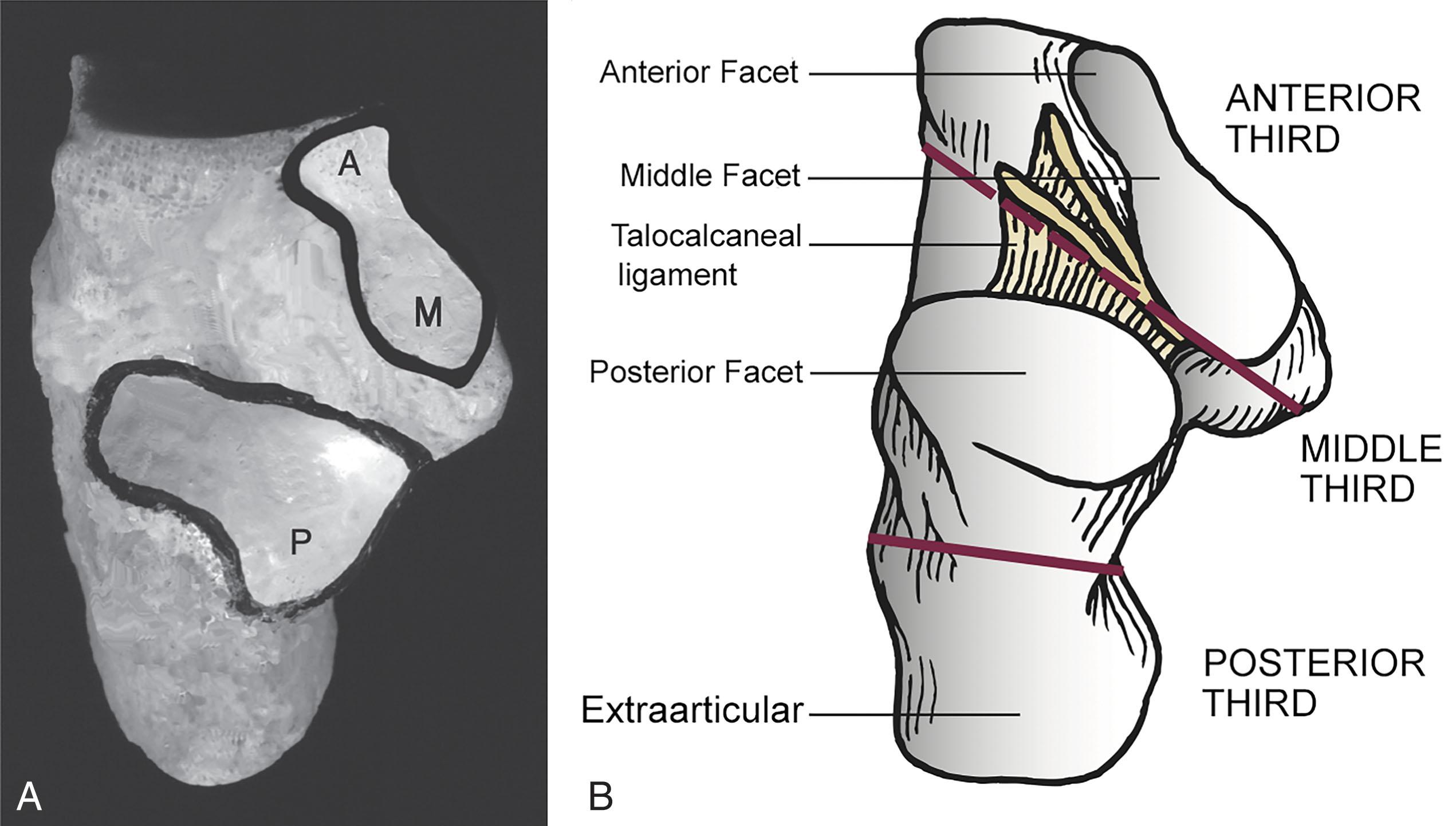
The anterior surface constitutes the calcaneal side of the calcaneocuboid joint and features a unique saddle shape, which is convex transversely and concave vertically. It is covered almost entirely with articular cartilage. The joint is supported by the thick ligaments plantarly and the stout bifurcate ligament superiorly. The bifurcate ligament extends from the anterior process of the calcaneus to the cuboid and navicular. With the talonavicular joint, the calcaneocuboid joint forms the midtarsal (Chopart) joint complex that has a common axis through the bifurcate ligament. Isolated fractures at the anterior process of the calcaneus should raise the suspicion for a Chopart joint injury.
The lateral surface includes the peroneal tubercle, an obliquely oriented bony prominence that anchors the inferior peroneal retinaculum. The peroneal tendons course along the lateral wall of the calcaneus, sitting in shallow grooves above (peroneus brevis) and below (peroneus longus) the peroneal tubercle. The origin of the calcaneofibular ligament is found posterior to the peroneal tubercle. The sural nerve lies posterior to the peroneal tendons and courses parallel to them before crossing them superficially at the level of the inferior peroneal retinaculum ( Fig. 45-2 ).
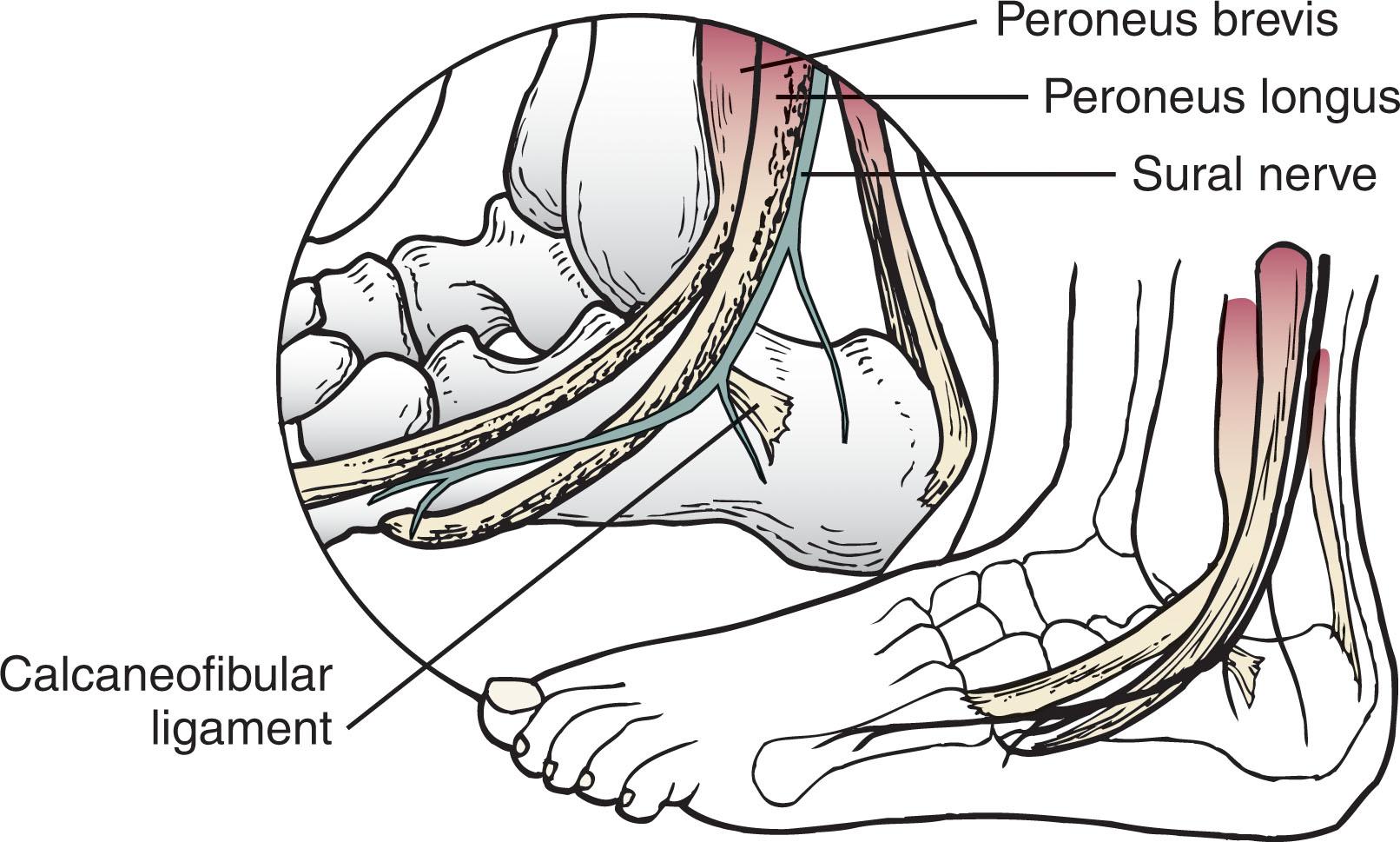
The medial surface is markedly stronger than the lateral wall. It includes the sustentaculum tali, which extends anterior medial and slightly superior to the calcaneal body and supports the neck of the talus. The sustentaculum is secured to the talus by the interosseous talocalcaneal ligament within the tarsal canal, the medial talocalcaneal ligament, and the deltoid ligament complex. The tibiocalcaneal portion of the superficial deltoid ligament typically provides stability to the sustentacular fragment in a displaced intraarticular calcaneal fracture. The flexor hallucis longus (FHL) tendon courses beneath the sustentaculum, and the flexor digitorum longus tendon runs directly over the sustentaculum. At this level, the medial plantar artery and nerve, terminal branches of the posterior tibial artery, and tibial nerve, respectively, lie between the abductor hallucis muscle and FHL tendon ( Fig. 45-3 ).
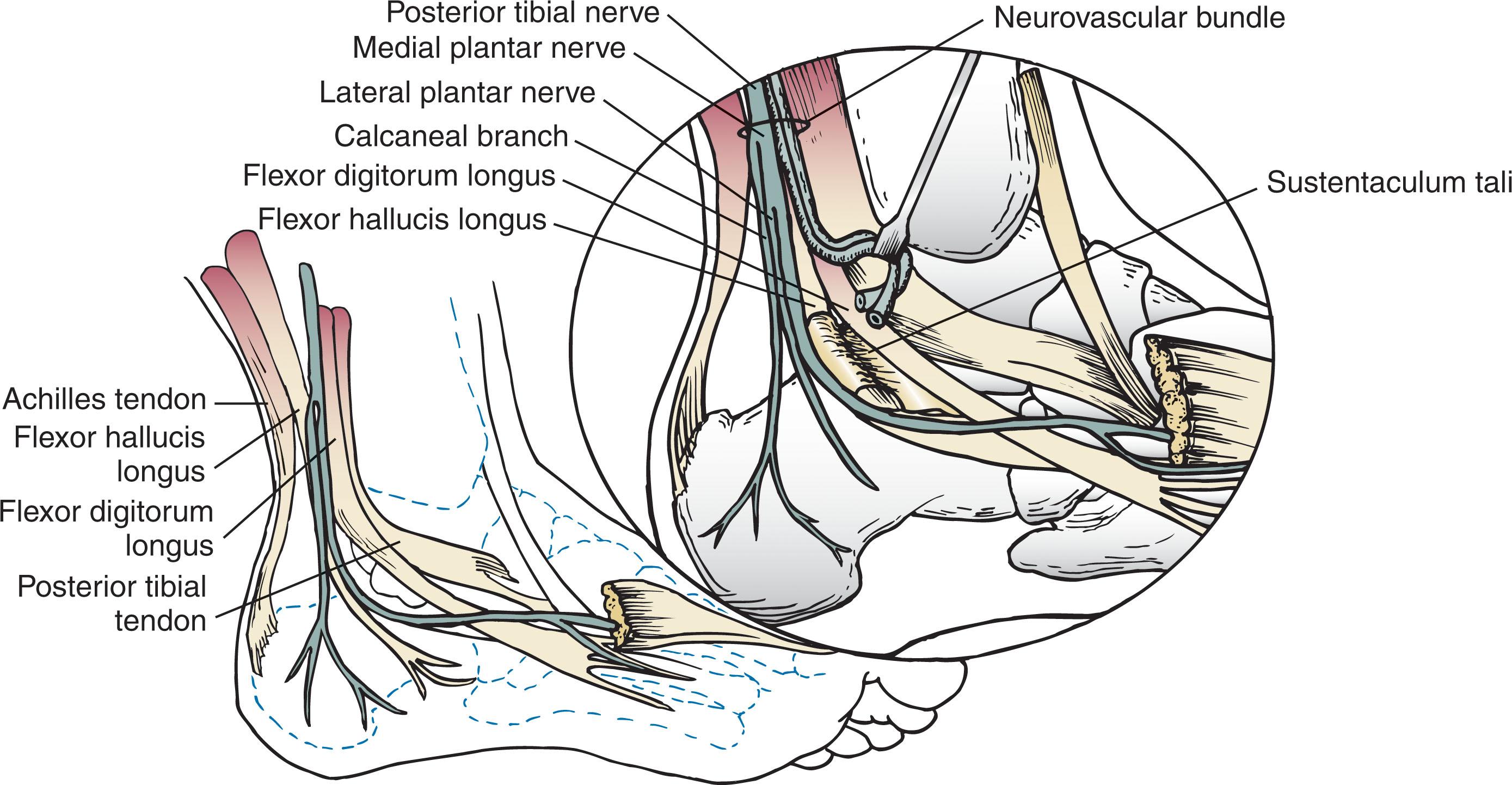
The inferior surface is long and triangular and includes the calcaneal tuberosity posteriorly as well as the lateral and medial processes at the anterior margin of the tuberosity. The lateral process serves as the origin for the abductor digiti quinti muscle, and the medial process is the origin of the abductor hallucis muscle and the main portion of the plantar fascia. The medial process also functions as the major weight-bearing structure in the hindfoot. The Achilles tendon inserts at the posterior-inferior surface of the calcaneal tuberosity.
The heel pad consists of a highly specialized and condensed collection of adipose tissue, which is contained by fibrous septa. These septa are vertically arranged in spiral fashion to resist torsional forces applied at heel strike of gait. They form chambers that are supported by transversely oriented elastic tissue fibers. This unique arrangement is critical to shock absorption with normal gait.
The lateral radiograph of the calcaneus demonstrates its unique topographic features. Compression trabeculae converge to provide support to the articular facets and merge with traction trabeculae radiating from the inferior cortex. This confluence of bony trabeculae forms a condensation of bone radiographically, which is known as the thalamic portion of the calcaneus , as described by Destot in 1911 and later by Soeur and Remy. The space between these trabeculae is referred to as the neutral triangle ( Fig. 45-4A ).
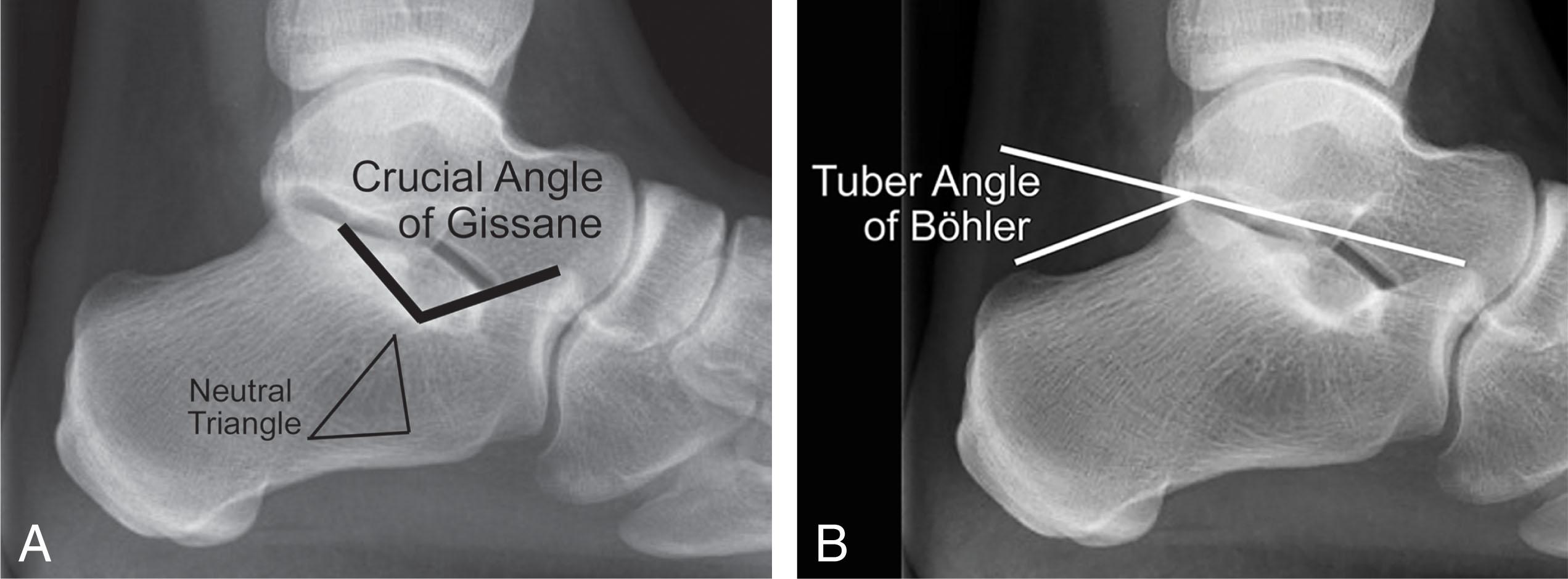
The crucial angle of Gissane is formed by the subchondral bone of the posterior facet and middle and anterior facets. The overlying dense cortical bone forms two thick cortical struts, one extending from the lateral margin of the posterior facet and the other extending anteriorly to the calcaneal beak, which combine to form an obtuse angle of 120 to 145 degrees. These struts provide support to the lateral process of the talus, which sits directly above (see Fig. 45-4A ).
The tuber angle of Böhler is formed by the intersection of a line drawn from the highest point of the anterior process of the calcaneus to the highest point of the posterior facet and a line drawn tangent to the superior edge of the calcaneal tuberosity ( Fig. 45-4B ). The angle varies individually between 20 and 40 degrees. It is decreased in the event of a calcaneal fracture and may in fact be reversed in severe fractures. A decreased angle suggests collapse of the posterior facet, which shifts the body weight anteriorly; however, because reduction or reversal of the angle reflects only the proximal displacement of the tuberosity relative to the articular surface, the angle may be decreased in both intraarticular and extraarticular fractures. Thus, the surgeon must bear this in mind in applying its absolute value in the evaluation and management of a calcaneal fracture.
About 90% of the blood supply to the calcaneus is provided by the posterior tibial artery through medial and lateral calcaneal arteries, with a watershed area between these arteries being in the midline of the calcaneal body. The remaining 10% of the calcaneal body receive vessels from the sinus tarsi artery. The medial and lateral calcaneal arteries form anastomoses with the malleolar network that receives input from the peroneal artery and the anterior tibial artery. The anterior process is supplied by the dorsalis pedis and medial and lateral tarsal arteries.
Intraarticular fractures result from a high-energy mechanism where an axial load on the lower limb drives the calcaneus up into the talus. The fracture pattern can depend on the position of the foot at impact, the amount of energy, and the bone quality. Displaced intraarticular fractures of the calcaneus generally occur in the event of high-energy trauma, such as a fall from a height, where the body weight of the patient is concentrated on the heel at the moment of impact, or a motor vehicle accident, in which case the affected foot is violently impacted by the floorboard or pedal of the car. The pattern of fracture lines and extent of comminution are somewhat variable and are determined by a variety of factors, including the position of the foot at impact, the extent of force involved at impact, and the patient’s overall bone quality. Although controversy remains as to the precise mechanism of injury, there is consensus to some degree among most authors.
Essex-Lopresti proposed that the primary fracture line was initiated laterally, with subsequent extension medially. He believed that at the moment of impact, the subtalar joint was forced into eversion such that the lateral process of the talus impacted the calcaneus at the crucial angle of Gissane, dividing the lateral wall and body of the calcaneus. The residual force then dissipated medially into the sustentaculum. With continuation of force, the fracture line extended into the anterior process or calcaneocuboid joint, thus producing an anterolateral fragment. A secondary fracture line then resulted from increased force: With a posteriorly directed force, the fracture line continued into and posterior to the posterior facet, producing a joint-depression fracture; with a more inferiorly directed force, the fracture line extended inferior to the posterior facet, producing a tongue-type fracture ( Fig. 45-5 ).
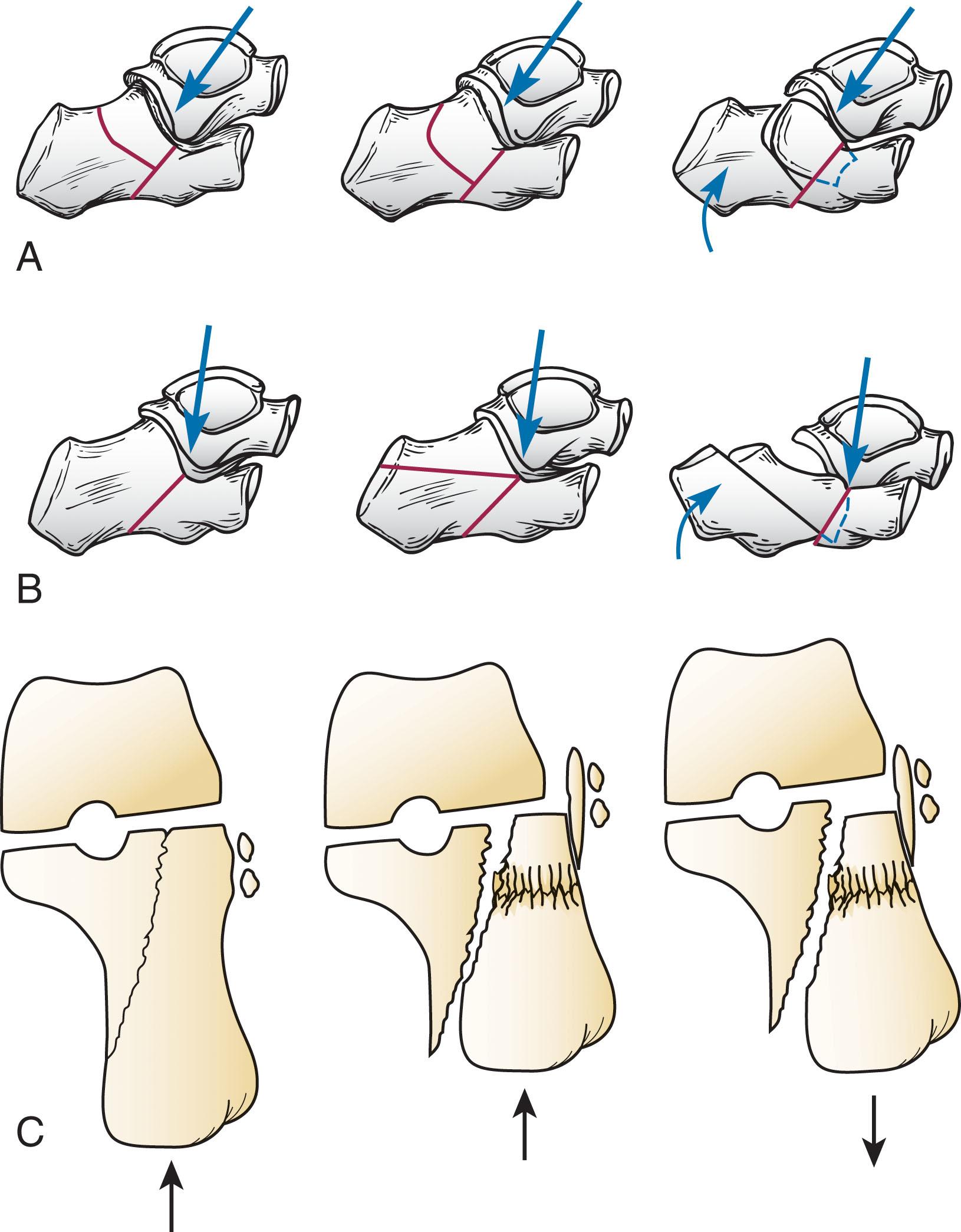
Carr et al created intraarticular calcaneal fractures experimentally using cadaveric models and analyzed the resulting pathoanatomy. Two primary fracture lines were consistently identified: One sagittal fracture line sectioned the calcaneus into medial and lateral fragments, whereby the fracture extended anteriorly into either the anterior facet or the calcaneocuboid joint; the coronal primary fracture line sectioned the calcaneus into anterior and posterior fragments, starting laterally at the crucial angle of Gissane and continuing medially, often dividing the middle facet. Laterally, this second primary fracture line often continued either inferiorly or anteriorly, exiting the plantar surface. These primary fracture lines produced a variety of fracture patterns, including joint depression and tongue-type fractures, as well as the commonly observed anterolateral, superolateral, and superomedial fracture fragments, thereby confirming the findings of Essex-Lopresti and others ( Fig. 45-6 ).
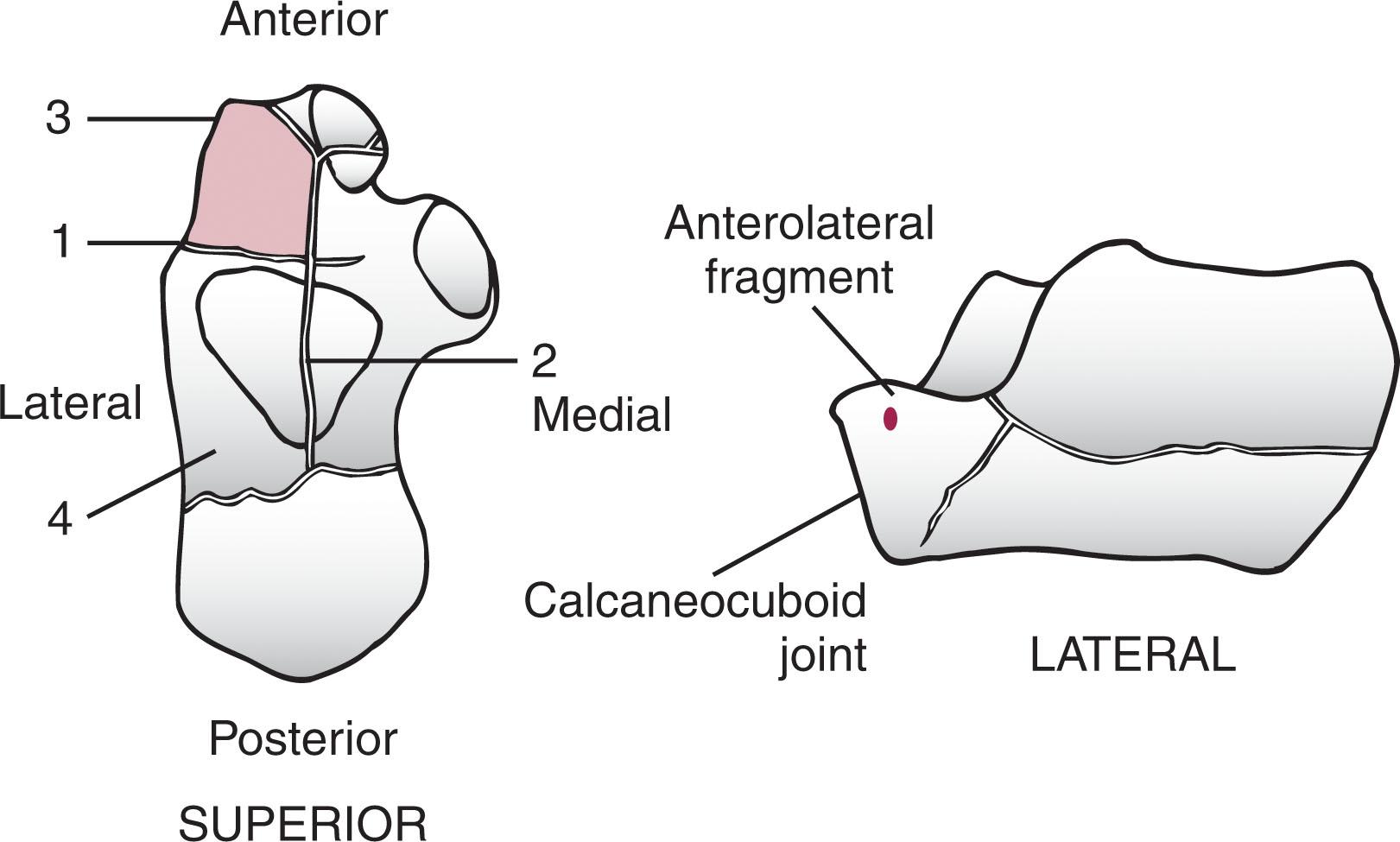
Because the axis of the calcaneus lies laterally to that of the talus, the tuberosity fragment is sheared off obliquely in a superolateral direction with respect to the fixed sustentacular fragment (see Fig. 45-5C ). The position of the hindfoot at the time of impact has a direct influence on the fracture pattern. With the hindfoot in pronation (valgus), the sagittal primary fracture line runs laterally, creating a large superomedial fragment; with the hindfoot in inversion (varus), the fracture line lies more medially. These biomechanical findings may explain the morphology of two-part fracture-dislocations and isolated fractures of the sustentaculum, respectively, and have been confirmed in computed tomography (CT) analyses.
With displaced intraarticular calcaneal fractures, clarification of fragment terminology is necessary to understand the pathoanatomy of these fractures. The anterior main fragment is the large fragment anterior to the primary fracture line, which typically includes the anterior portion of the sustentaculum and anterior process. The anterolateral fragment refers to the lateral wall of the anterior process; this fragment is typically pyramid shaped and can include a portion of the calcaneocuboid articular surface. The anteromedial fragment is usually smaller and contains the anterior facet and the medial portion of the calcaneocuboid articular surface. The superomedial fragment is the fragment of variable size found posterior to the primary fracture line; this fragment is also known as the sustentacular or constant fragment because the fragment almost always remains attached to the talus through the deltoid ligament complex and is therefore stable. The superolateral fragment , also referred to as the semilunar or comet fragment , is the lateral portion of the posterior facet that is sheared from the remaining posterior facet in joint depression fractures. The tongue fragment refers to the superolateral fragment that remains attached to a portion of the posterior tuberosity, including the Achilles tendon insertion, and is found in tongue-type fractures. The posterior main fragment represents the posterior tuberosity.
In the event of a displaced intraarticular calcaneal fracture, the loss of height through the calcaneus results in a shortened and widened heel, typically with varus malalignment of the tuberosity. This loss of height is reflected in a decreased tuber angle of Böhler such that the normal declination of the talus is diminished, and the talus becomes relatively more horizontal, which leads to secondary loss of ankle dorsiflexion. As the superolateral fragment of the posterior facet is impacted plantarward, the thin lateral wall explodes laterally just posterior to the crucial angle of Gissane. This lateral wall expansion can trap the peroneal tendons against the lateral malleolus and can also affect subtalar motion. In some cases, a violent contracture of the peroneal tendons avulses the tendon sheath from the fibula, resulting in an avulsion fracture of the lateral malleolus and dislocation of the peroneal tendons. The anterior process typically displaces superiorly, which directly limits subtalar joint motion by impinging against the lateral process of the talus ( Fig. 45-7 ) and directly affecting congruity of the calcaneocuboid joint.
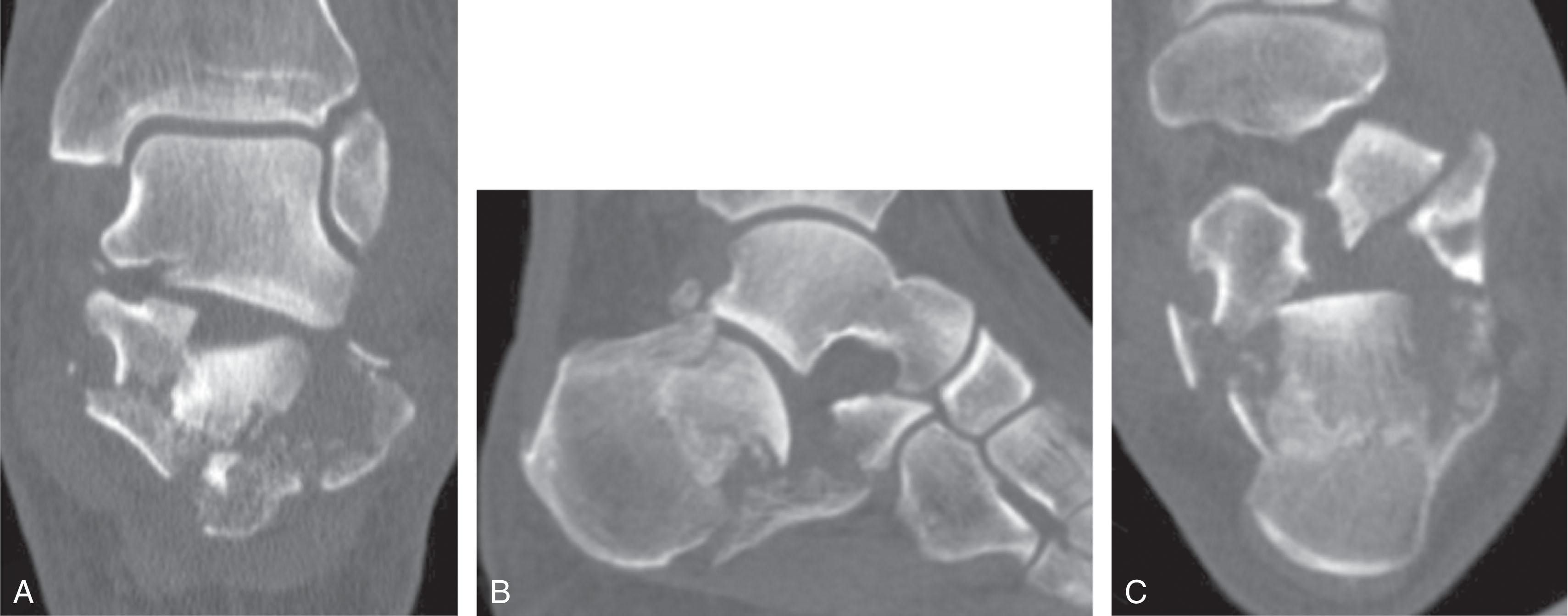
With intraarticular calcaneal fractures, as with all fractures, the severity of fracture displacement and extent of soft tissue injury are directly related to the amount of energy applied to the involved limb in producing the fracture. Although lower-energy injuries result in only mild swelling and ecchymosis, higher-energy injuries produce severe soft tissue disruption and can result in an open fracture. Fracture bleeding into the tightly enveloped fascial planes surrounding the heel typically produces severe pain overlying the fracture, and within several hours after the injury, the extent of soft tissue swelling is such that the normal skin creases in the area disappear.
Four main compartments exist within the foot: medial, lateral, central, and interosseous. The central compartment is further divided by a transverse septum into the superficial compartment, which contains the flexor digitorum brevis muscle, and the deep or calcaneal compartment, which contains the quadratus plantae muscle and lateral plantar nerve and communicates directly with the deep posterior compartment of the lower leg.
Severe swelling and hemorrhage within a closed fascial space raises the intracompartmental pressure, which first obstructs venous outflow and, if unrecognized and severe enough to affect pulse pressure, diminishes arterial flow. The hallmark of a compartment syndrome is pain out of proportion to the injury that does not respond to rest, elevation, cooling, and immobilization. Loss of sensation over the sole of the foot is an alarming sign of increased compartmental pressure over several hours.
The long-term sequelae of an unrecognized compartment syndrome in the foot include claw toe deformities with contracture, weakness, sensory disturbances, painful callus formation, and permanent loss of function. Hence, care should be taken to ensure that the extreme pain associated with the fracture is not in fact due to a compartment syndrome, especially in the deep central (calcaneal) compartment. A self-contained needle manometer system (Quikstik; Stryker, Kalamazoo, MI) can be used to measure compartment pressures and assist in establishing the diagnosis, especially in unconscious patients. Fasciotomy is generally recommended when compartment pressures are within 10 to 30 mm Hg of the patient’s diastolic blood pressure.
Fracture blisters can arise anywhere about the foot in the event of severe swelling. A blister occurs as a result of cleavage at the dermal–epidermal junction, which produces a sterile transudate within the blister. The fluid remains clear if the dermis retains some epidermal cells, but it can become bloody if the dermis is fully devoid of epidermal cells.
A variety of treatment methods have been described in the management of fracture blisters, including aspirating the blister, unroofing the blister and applying silver sulfadiazine (Silvadene) cream or nonadherent dressing, and leaving the blister intact and covered with loose gauze or exposed to air. Although there is no consensus as to the optimal management of fracture blisters, most authors recommend modification of surgical incisions to avoid areas of blistered skin, particularly blood-filled blisters ( Fig. 45-8 ).
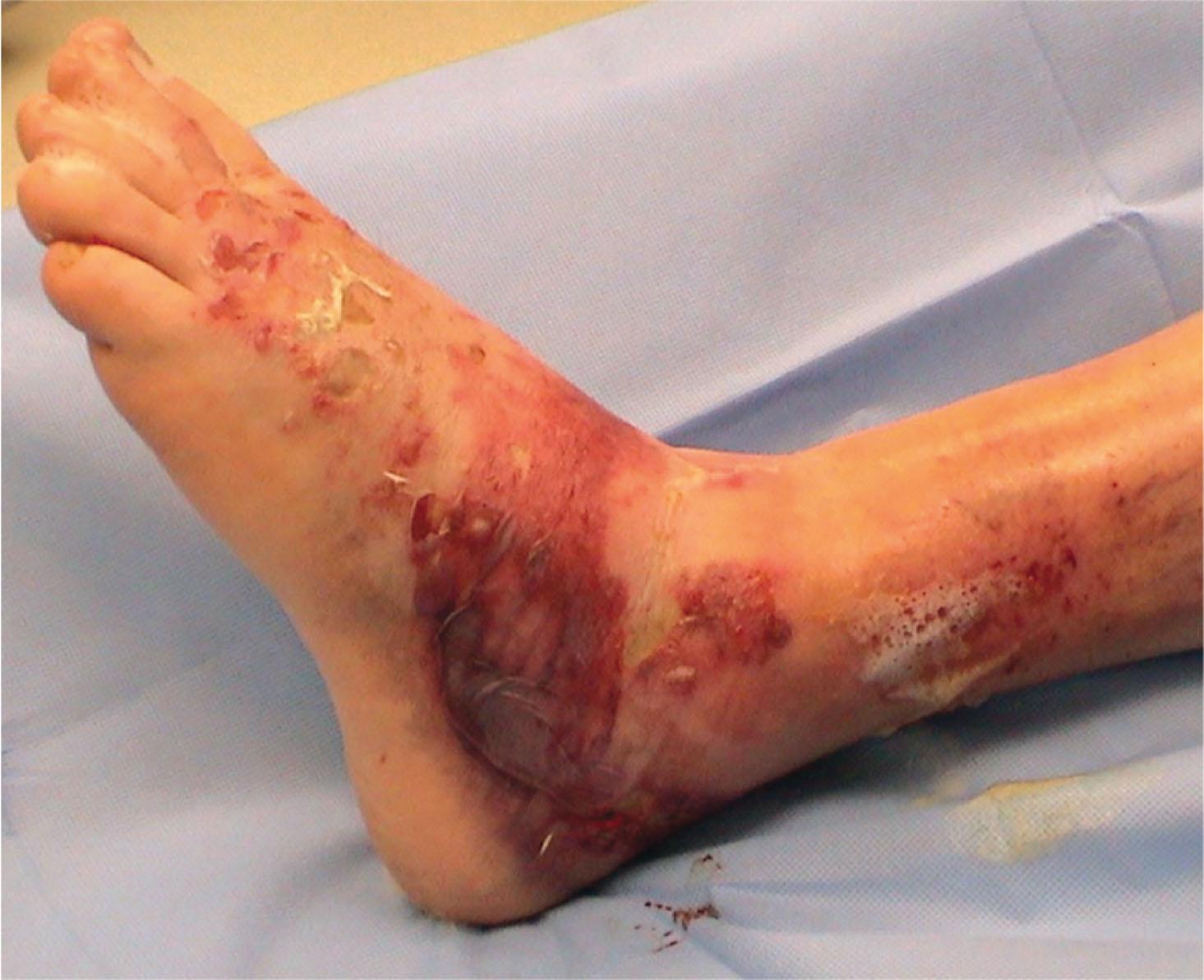
Open fractures of the calcaneus comprise up to 17% of all calcaneal fractures and represent distinct injuries requiring different treatment from closed fractures. Open injuries are associated with increased treatment costs and time off work. They are generally associated with a higher complication rate, including wound complications, deep infection, osteomyelitis, and subsequent need for amputation, and the incidence of these complications appears to increase with increasing severity of the soft tissue injury.
Folk et al reported wound complications in 72% of open calcaneal fractures treated operatively in their series, and they estimated that patients with an open fracture were 2.8 times more likely to develop a wound complication than patients with a closed fracture. In other studies, the risk of wound complications and infections were increased up to fivefold compared with closed fractures. Siebert et al reported a 60% incidence of osteomyelitis in type III open fractures treated with internal fixation. Other more recent reports have emphasized the importance of aggressive, thorough surgical debridement of the open wound, provisional stabilization of the involved limb where necessary, and delayed open reduction and internal fixation (ORIF) of the fracture once the wound is clean and deemed suitable for surgery. Despite these measures, significant wound complications, deep infection, and osteomyelitis can still develop in up to 19% of cases. Even in the absence of these complications, most patients can expect a functional outcome far worse than with closed fractures, particularly for patients with a plantar wound. Heier et al concluded that the degree of soft tissue injury was the most important factor in predicting outcome.
Open fractures of the calcaneus vary from a simple puncture wound medially, such as from a spike of bone from the medial wall of the calcaneus, to a more significant wound with marked soft tissue disruption posteriorly or laterally ( Fig. 45-9 ). In severe cases, the injury can include dislocation of the talonavicular joint, whereby the talar head is driven through the anterior calcaneus and might even exit through the plantar skin.
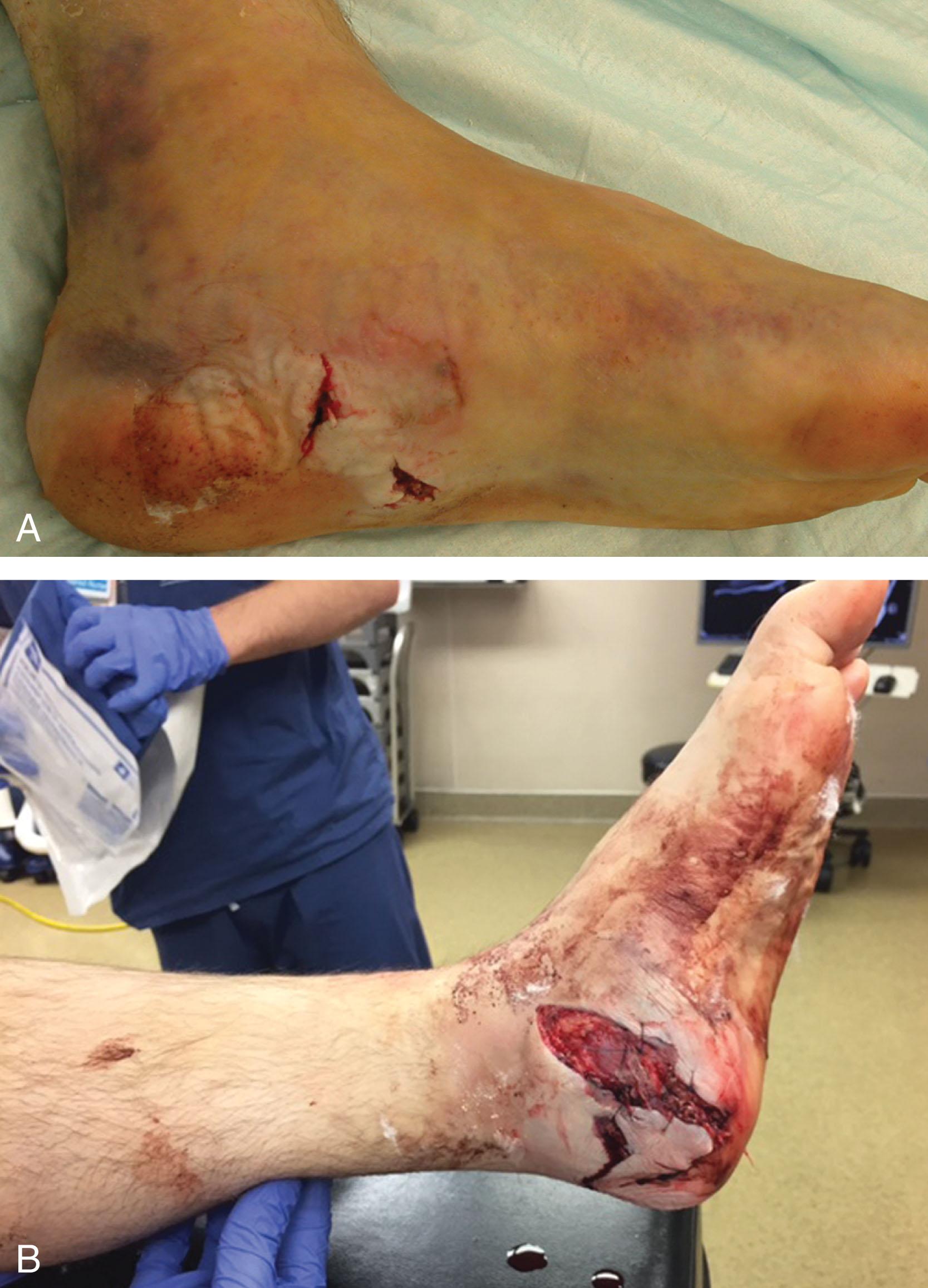
In evaluating an open calcaneal fracture, the wound size and location should be assessed, and the injury should be classified using the system of Gustilo and Anderson. In an analysis of 127 open calcaneal fractures, Wiersema et al found medial-based wounds in 54.8% of cases; 64 fractures were graded Gustilo types I or II, and 51 fractures were graded Gustilo type III, among them 5 type IIIC. These factors provide the surgeon perspective for the severity of the injury and thus a realistic prognosis for the patient.
As with all open fractures, initial management includes intravenous antibiotics, thorough surgical debridement and pulsed lavage irrigation of the wound, and provisional stabilization of the limb. Closed reduction and temporary percutaneous fixation may be used where necessary, either with Kirschner wires (K-wires) or with an external fixator construct. Further treatment is dictated by the extent and location of the soft tissue injury, and each open injury should be individualized in formulating a treatment plan. Early, aggressive fracture stabilization should, however, be avoided so as to prevent further trauma to the limb. Definitive surgical treatment may need to be delayed for up to 3 months to allow adequate soft tissue healing, in which case the injury is managed as calcaneal malunion. On the other hand, early and stable soft tissue coverage using free microvascular flaps in combination with fracture fixation may reduce the rate of severe complications and improve functional outcome by avoiding excessive scarring in complex injuries. This approach requires close collaboration with plastic surgeons from the first day of presentation.
Heier et al recommended that all open type I fractures and open type II fractures with a medial wound be treated by ORIF with standard techniques once the soft tissue swelling has adequately diminished. External fixation or limited percutaneous fixation is used for open type II injuries with nonmedial wounds and all open type IIIA wounds. Delayed or late reconstruction is reserved for all open type IIIB wounds and for injuries resulting from penetrating trauma. Recently, Mehta et al saw only one low superficial and one deep infection (7.1%) in a series of 14 type II or IIIA medially open calcaneal fractures with a staged protocol of debridement, irrigation and percutaneous fixation within 8 hours, and definite lateral plate fixation via an extensile laterally based approach within 18 days. For select open fractures with a medial wound and limited articular damage, even acute fixation via a lateral approach appears feasible.
Associated injuries, including lumbar spine fractures or other lower extremity fractures, have historically occurred in up to 50% of patients with calcaneal fractures. More recent estimates suggest that up to 10% of patients with calcaneal fractures have lumbar spine fractures, and approximately 25% have other associated lower extremity injuries. These associated injuries are more common with higher-energy calcaneal fractures, and the surgeon must maintain a high index of suspicion. Thorough radiographic evaluation should be performed where indicated. In multiple injured or polytraumatized patients, closed calcaneal fractures might go unnoticed because of more obvious or even life-threatening injuries. However, if the patients survive the critical period, foot injuries make up for most of the permanent diability.
The initial radiographic evaluation of a patient with a suspected calcaneal fracture includes plain radiographs of the involved foot and ankle, including a lateral view of the hindfoot, an anteroposterior (AP) view of the foot, an axial view of the heel, and a mortise view of the ankle. This combination should reveal almost any fracture, dislocation, or subluxation in the hindfoot. Plain radiographs of the lumbar spine are also routinely obtained in light of the association between lumbar spine injuries and calcaneal fractures, particularly those involving a fall from a height.
Typically, the lateral view of the hindfoot most readily demonstrates a fracture of the calcaneus, and with an intraarticular fracture, the lateral view shows whether the fracture is a joint depression or tongue-type fracture according to the classification of Essex-Lopresti. A loss of height in the posterior facet is another feature of these fractures: the articular surface is impacted within the body of the calcaneus and usually rotated anteriorly up to 90 degrees relative to the remaining subtalar joint. A decreased tuber angle of Böhler and an increased crucial angle of Gissane are seen in fracture patterns where the entire posterior facet is separated from the sustentaculum and depressed ( Fig. 45-10A ). If only the lateral portion of the posterior facet is involved, the split in the articular surface is manifest as a double density, in which case the tuber angle of Böhler and crucial angle of Gissane can remain normal ( Fig. 45-10B and C ). If a calcaneal fracture is obvious in the lateral view, no further plain radiographs are needed, and CT scanning should be done to reveal the exact size and location of the main fragments as well as joint involvement.
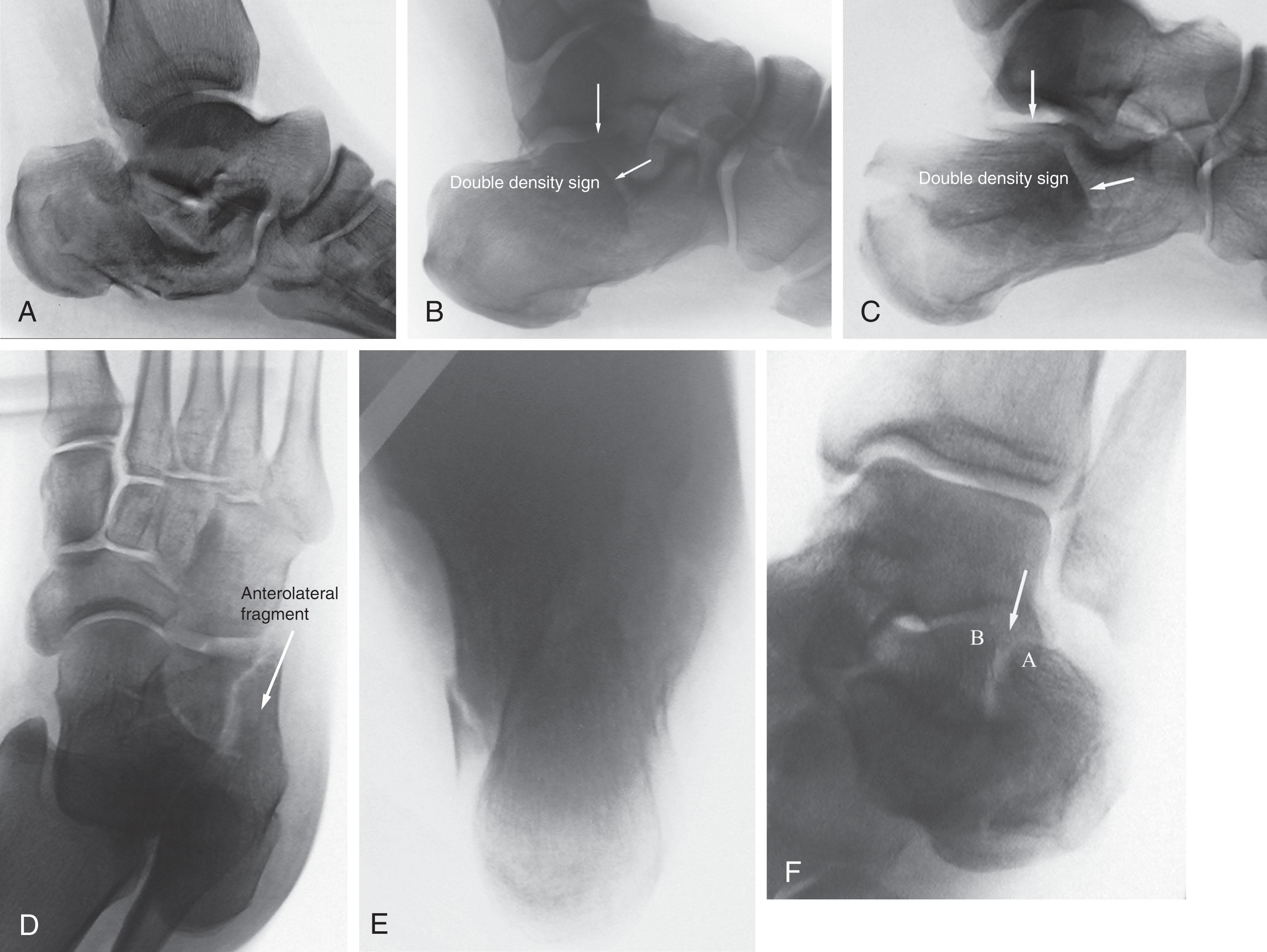
The AP view of the foot usually reveals extension of fracture lines into the calcaneocuboid joint, and it can also demonstrate anterolateral fragments and expansion of the lateral calcaneal wall. This view otherwise offers only limited information and can be omitted in most cases ( Fig. 45-10D ).
The non–weight-bearing axial view of the heel shows a loss of calcaneal height, increased width and (typically) varus angulation of the tuberosity fragment, and visualization of the articular surface. Because of the pain of acute fractures, a weight-bearing (Harris) axial view or Saltzman heel alignment view is difficult to obtain ( Fig. 45-10E ).
A mortise view of the ankle usually demonstrates involvement of the posterior facet, broadening of the lateral wall, and abutment of the lateral malleolus with fracture-dislocations ( Fig. 45-10F ). A specialized view of the ankle, known as a Brodén view or Brodén projection I, more effectively reveals the posterior facet articular surface. The view is obtained with the patient supine and the x-ray cassette under the ankle, the foot positioned in neutral flexion, and the leg internally rotated 30 to 40 degrees. The x-ray beam is centered over the lateral malleolus, and four views are obtained with the tube angled at 10, 20, 30, and 40 degrees, respectively, toward the head of the patient. These views then demonstrate the posterior facet, working from posterior to anterior: the 10-degree view shows the posterior portion of the facet, and the 40-degree view shows the anterior portion ( Fig. 45-11 ). Although these images can be difficult to reproduce in an emergency room or office setting, this view should be used intraoperatively because it is invaluable in verifying reduction of the posterior facet articular surface.
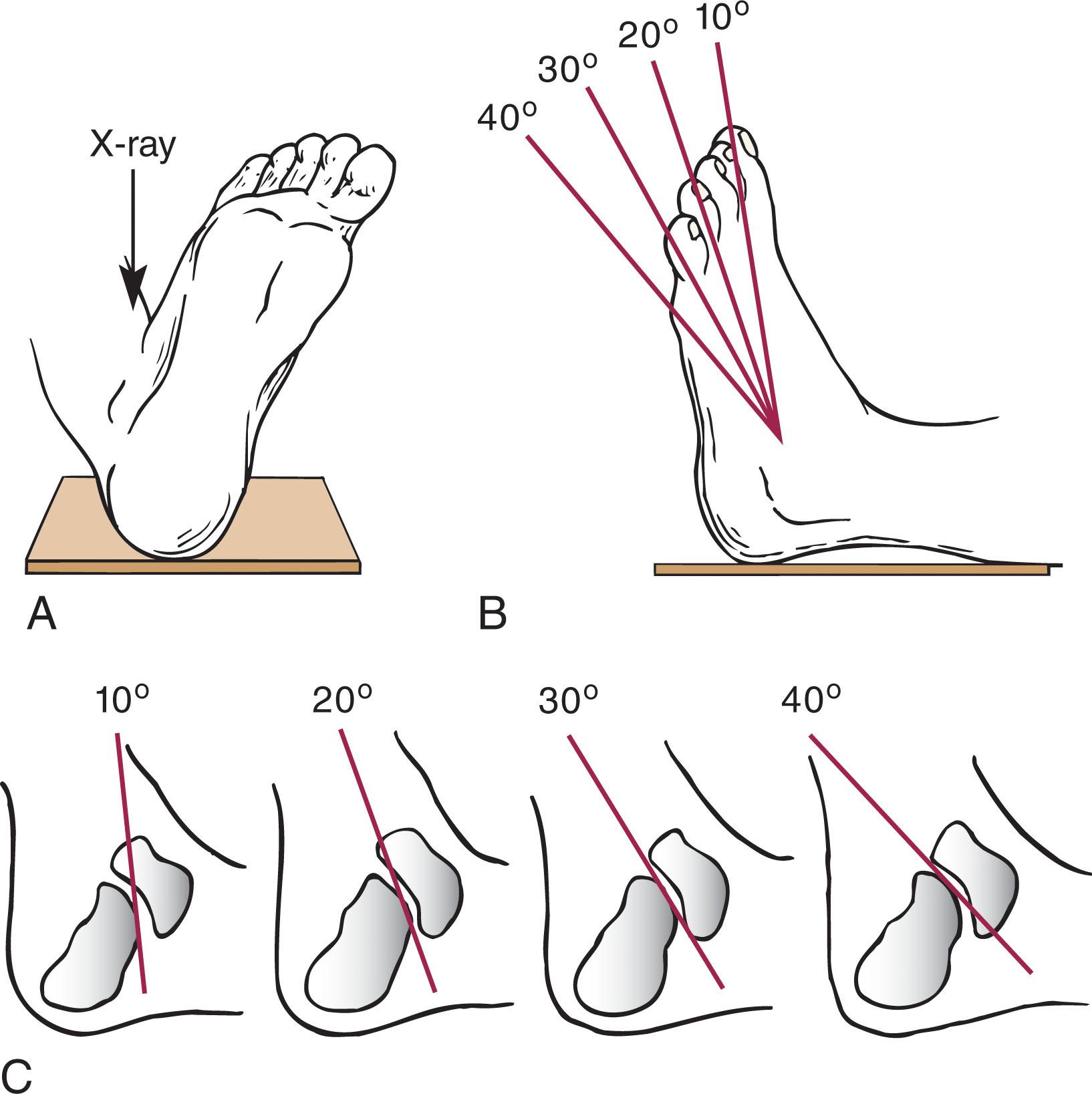
If the plain radiographs reveal intraarticular extension of the calcaneal fracture, CT scanning is indicated. A CT scan, as with any intraarticular fracture, provides information that is imperative in the diagnosis, classification, and subsequent treatment of a calcaneal fracture.
CT scanning has truly revolutionized our understanding of the pathoanatomy of calcaneal fractures, and as a result, it has allowed critical analysis of the results of treatment. Images are usually obtained in the semicoronal plane in less than 2-mm intervals and are recalculated in the axial, sagittal, and coronal planes ( Fig. 45-12 ). The axial or transverse cuts reveal extension of fracture lines into the anterior process and calcaneocuboid joint, as well as the sustentaculum tali and anteroinferior margin of the posterior facet. The sagittal reconstruction views demonstrate displacement of the tuberosity fragment and extent of involvement of the anterior process region, including superior displacement of the anterolateral fragment, anterior rotational displacement of the superolateral posterior facet fragment, and delineation of the fracture as a joint depression or tongue-type pattern. The 30-degree semicoronal images show displacement of articular fragments in the posterior facet, the sustentaculum tali, the extent of widening and shortening of the calcaneal body, expansion of the lateral calcaneal wall, varus angulation of the tuberosity, and position of the FHL and peroneal tendons ( Fig. 45-13 ).
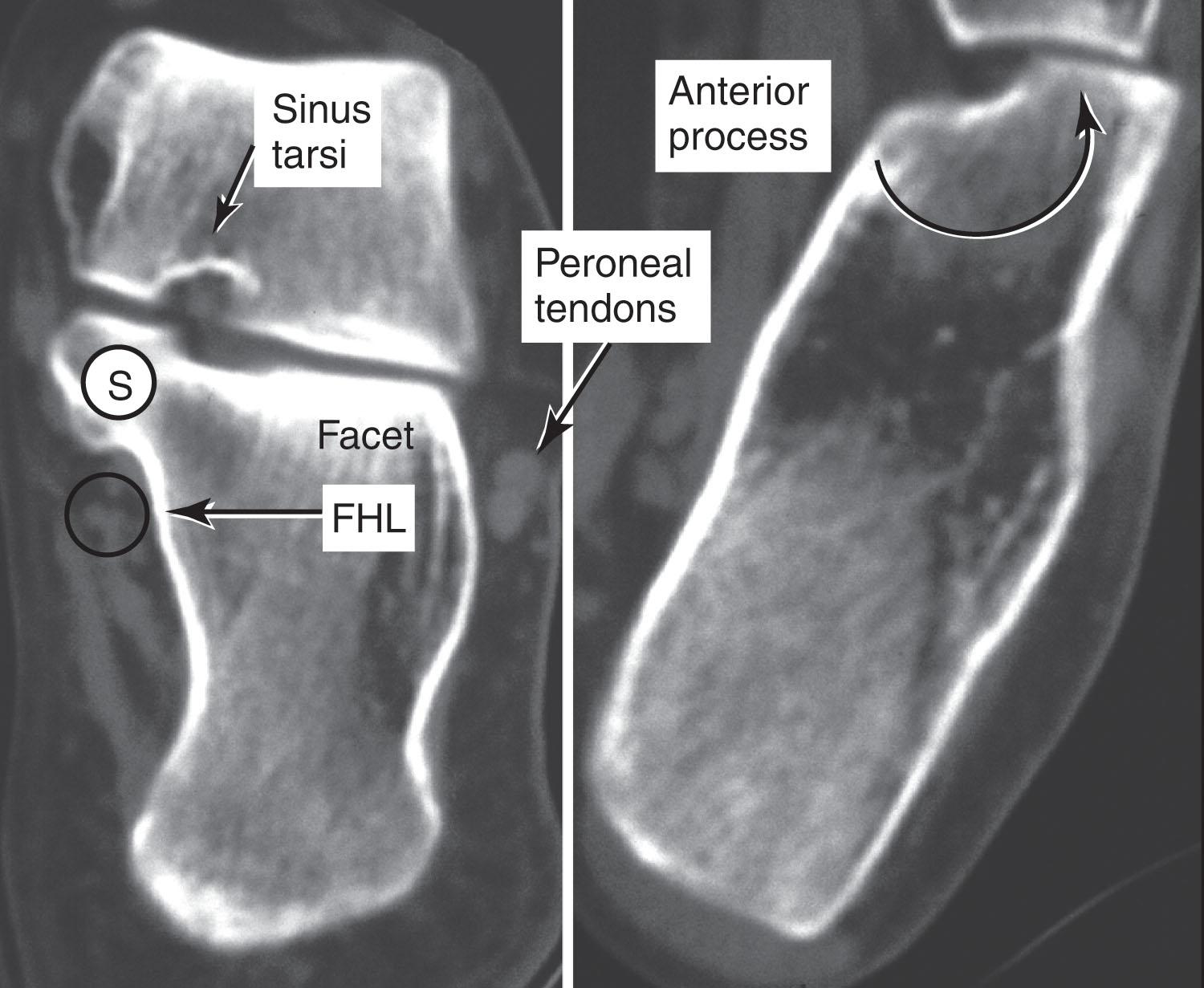
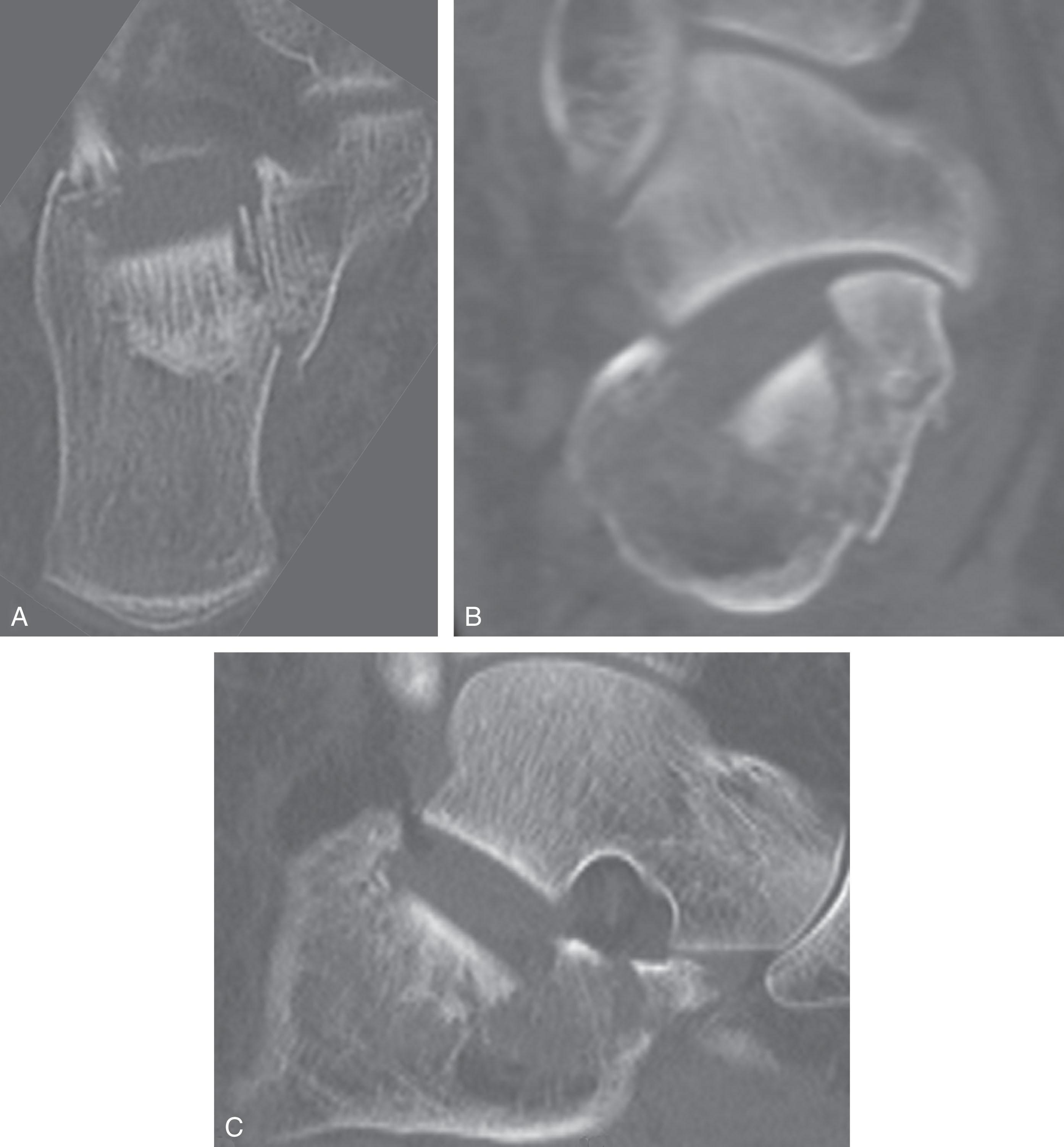
Three-dimensional CT scanning for intraarticular calcaneal fractures is an interesting diagnostic modality. Vannier et al concluded that three-dimensional CT has no greater diagnostic value than conventional two-dimensional CT. As resolution increases and newer technology such as additive three-dimensional printing become common place, the use of three-dimensional reconstructions may improve surgeon understanding of complex fracture patterns prior to embarking on surgery ( Fig. 45-14 ). Magnetic resonance imaging (MRI) has no significant role in examining acute fractures but may detect stress fractures, necrosis, tumor, or soft tissue problems in chronic cases. Technetium bone scanning is nonspecific but may identify the source of pain in posttraumatic conditions.
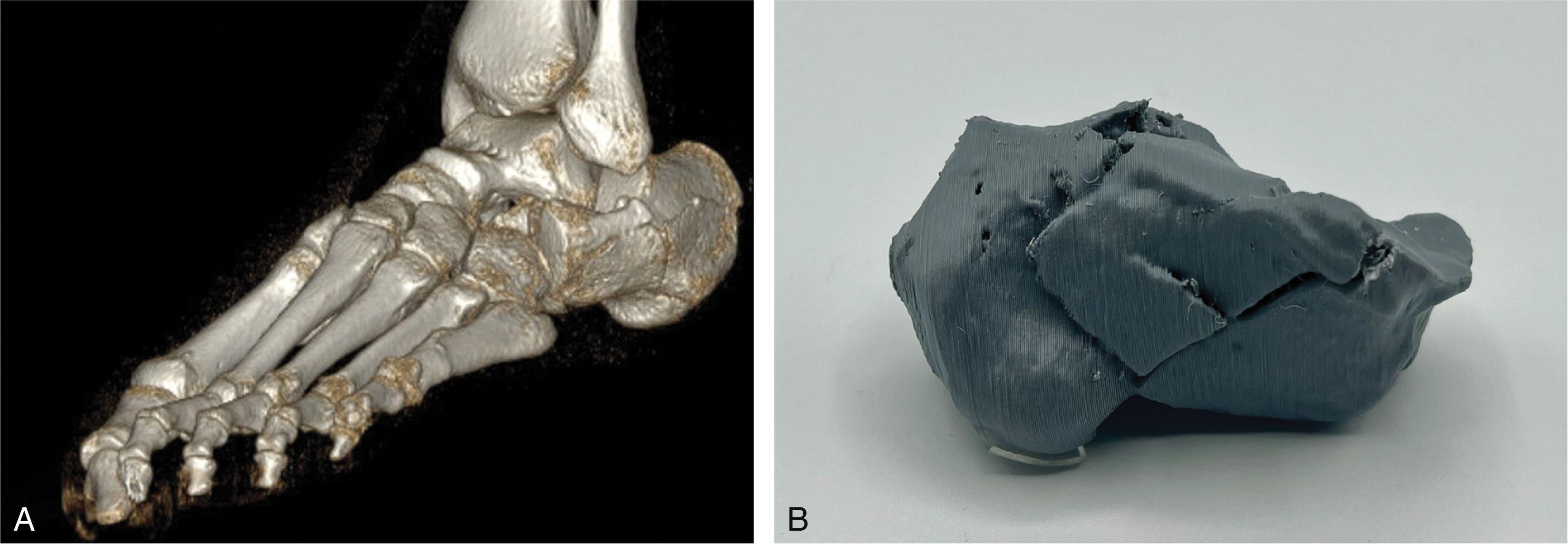
Classification systems are used to facilitate communication among surgeons, augment preoperative planning, and assist in outcomes analysis after treatment, and therefore they must be sufficiently reproducible to be of use. Classification systems based on plain radiography have long existed, but they have been only marginally useful, in part because of variations in imaging technique and limited accuracy in delineating fracture patterns. Thus the inability to accurately and consistently classify calcaneal fractures has undoubtedly contributed to the historical difficulty in treating these injuries. The development of CT scanning has revolutionized the management of calcaneal fractures because it has allowed imaging techniques to become standardized, leading to the development of modern classification systems.
Böhler was probably the first to provide an extensive fracture classification system. Eight groups of fractures were described, four of them extraarticular (1–4) and four intraarticular (5–8). A broad range of different fracture pathologies was covered by this classification, including beak fractures (group 1), isolated sustentacular fractures (group 3), classic dislocations of the posterior facet (groups 5 and 6) as well as dislocations in the talonavicular (group 7), and calcaneocuboid joint (group 8). Essex-Lopresti in 1952 developed a classification based on the presence of two distinct intraarticular fracture patterns, which further refined the work of Palmer. These patterns included a joint depression fracture, where the articular fragment was separate from the adjacent tuberosity fragment, and a tongue-type fracture, where the articular surface remained attached to the tuberosity fragment. By accurately classifying the fracture, the surgeon was able to determine the appropriate method of treatment; the classification, however, yielded no prognostic information. Other subsequent fracture patterns and classifications were essentially variations of the Essex-Lopresti classification.
Soeur and Remy, in 1975, proposed a new classification system based on the number of articular fragments seen on AP, lateral, and Harris axial heel views. First-degree fractures were nondisplaced shear-type fractures with widening of the joint surface. Second-degree fractures included secondary fracture lines, which produced at least three fragments, two of which involved the articular surface. Third-degree fractures were highly comminuted, whereby they “defied description” such that the authors could not accurately determine if the comminution involved the posterior facet articular surface or the body of the calcaneus. Although they advocated surgical management with internal fixation for displaced intraarticular fractures, their results did not correlate with their classification.
The use of CT scanning in the diagnosis and management of calcaneal fractures was first reported by Segal et al and later by Stephenson. Zwipp et al developed a classification system encompassing the entire calcaneus, with a total of five possible fracture fragments; this system was similar to the classifications of Essex-Lopresti and Soeur and Remy. Zwipp’s group, however, was the first to integrate information from the CT scan toward a logical understanding of the fracture. They further included the number of affected joint facets and the degree of soft tissue damage into a 12-point scoring system that was of prognostic relevance.
Crosby and Fitzgibbons developed a classification system based on displacement of the articular surface, and they were the first to correlate a CT-based classification system with clinical outcome (although after nonoperative treatment). In their system, fractures were divided into three types: type I, nondisplaced; type II, displaced; and type III, comminuted.
Sanders et al subsequently described a classification system based on the number and location of articular fragments alone, which they found to be useful in determining both treatment and prognosis after surgical management; several other authors have since found the system to be prognostic of outcome as well.
The system of Sanders et al is based on images in the coronal plane and is an extension of the fracture patterns described by Soeur and Remy. They arbitrarily selected the one image depicting the widest undersurface of the posterior facet of the talus (although the entire CT scan should be studied to follow fracture lines in and out of plane). The talus is divided into three separate columns by two lines extending across the posterior facet of the calcaneus; a third line is added just medial to the medial edge of the posterior facet, thus dividing the posterior facet of the calcaneus into three potential fragments: lateral, central, and medial. These fragments, plus the sustentaculum, give a total of four potential articular fragments. The fragments are then further subclassified by letter designation to denote the location of the primary fracture line from lateral to medial ( Fig. 45-15 ).
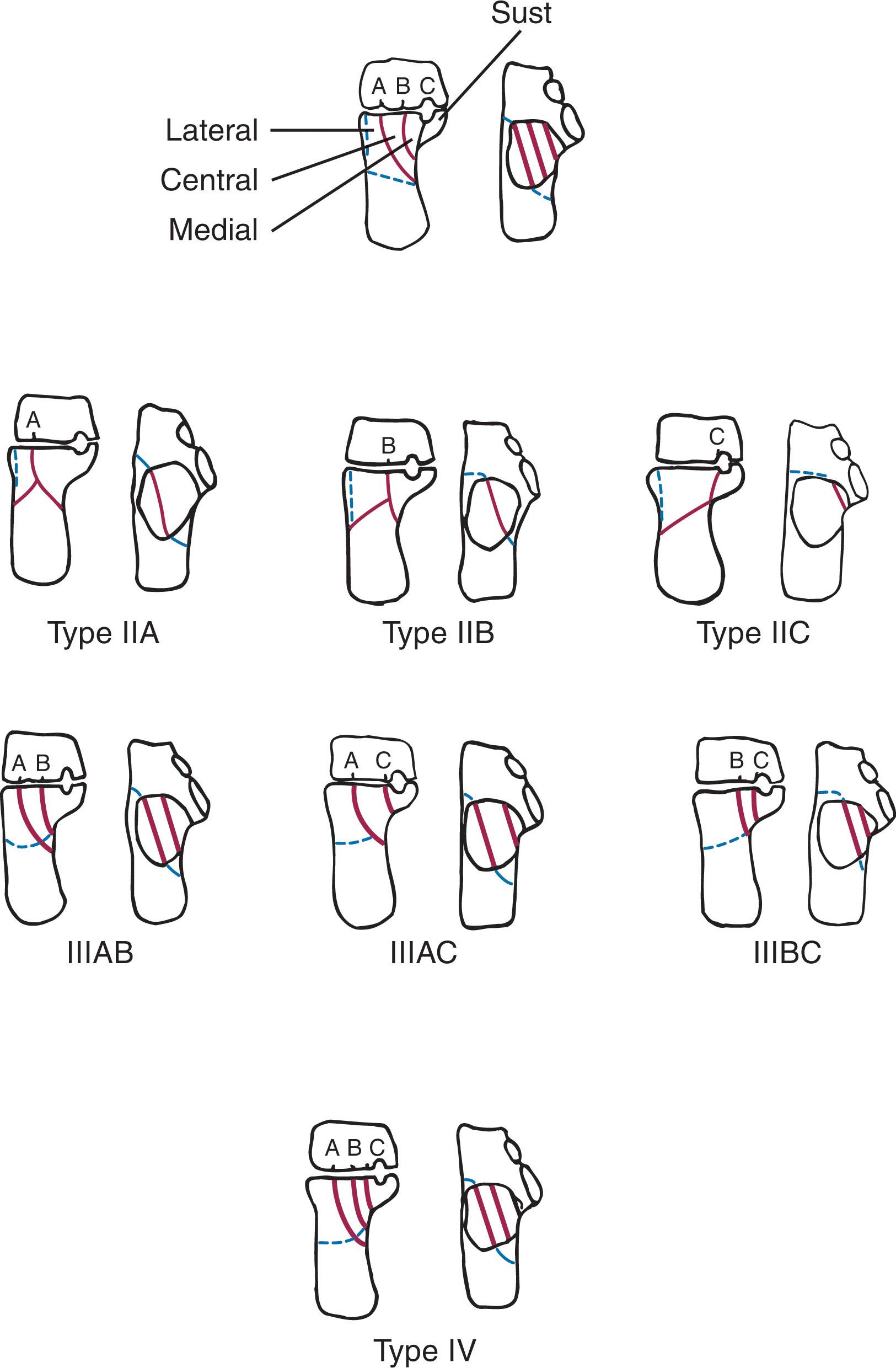
All nondisplaced (less than 2 mm) articular fractures are considered type I fractures, regardless of the number of fracture lines ( Fig. 45-16 ). Type II fractures are two-part fractures of the posterior facet, with three possible subtypes: IIA, IIB, and IIC, depending on the location of the primary fracture line ( Fig. 45-17 ). Type III fractures are three-part fractures, which typically include a centrally depressed fragment. There are three possible subtypes: IIIAB, IIIAC, and IIIBC, again depending on the location of the primary fracture line(s) ( Fig. 45-18 ). Type IV fractures are four-part fractures. These are highly comminuted fractures and often have more than four articular fragments ( Fig. 45-19 ). Although the subclassification of articular fragments has prognostic implications, many surgeons elect to simply identify the number of articular fragments.
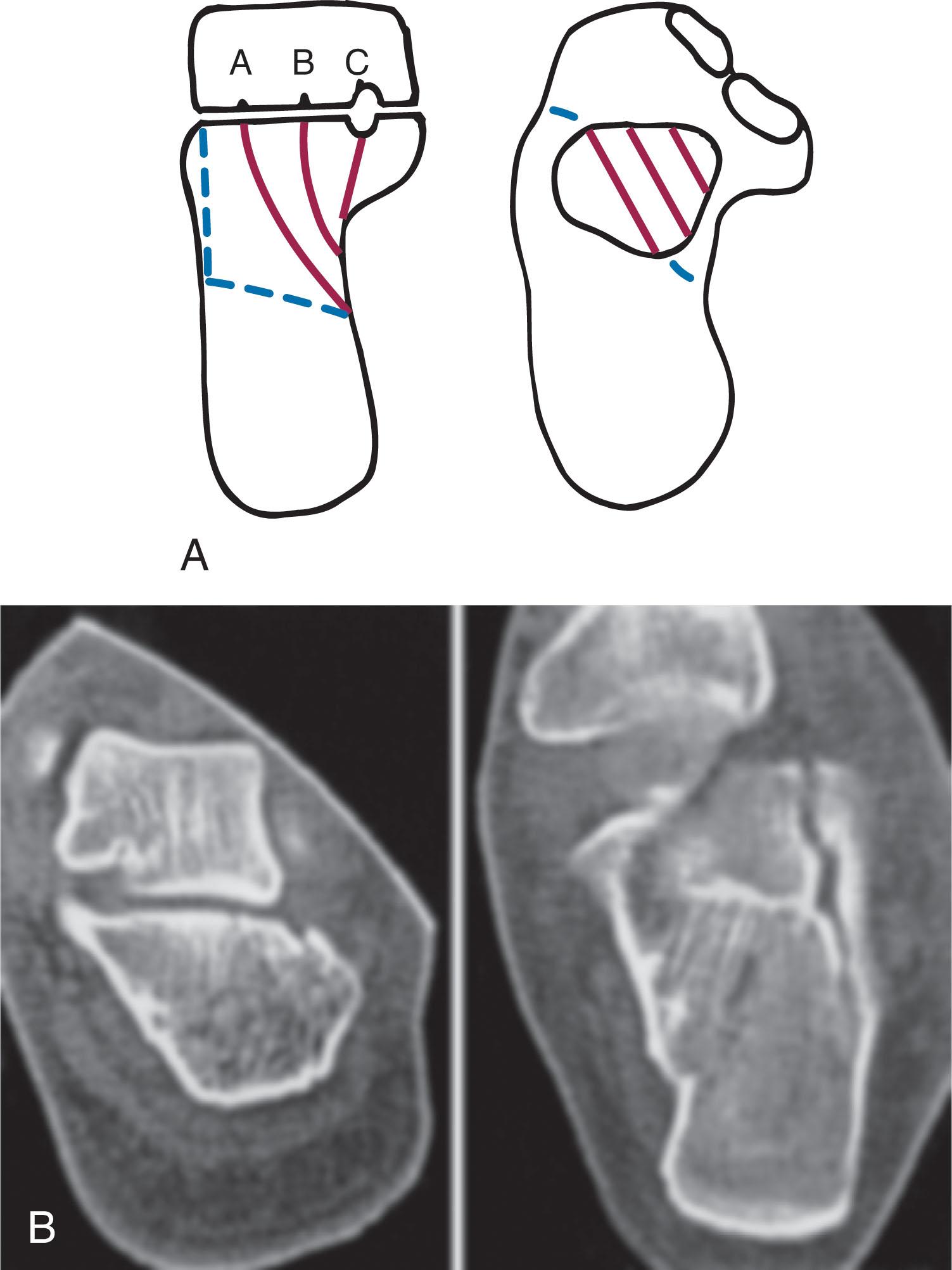
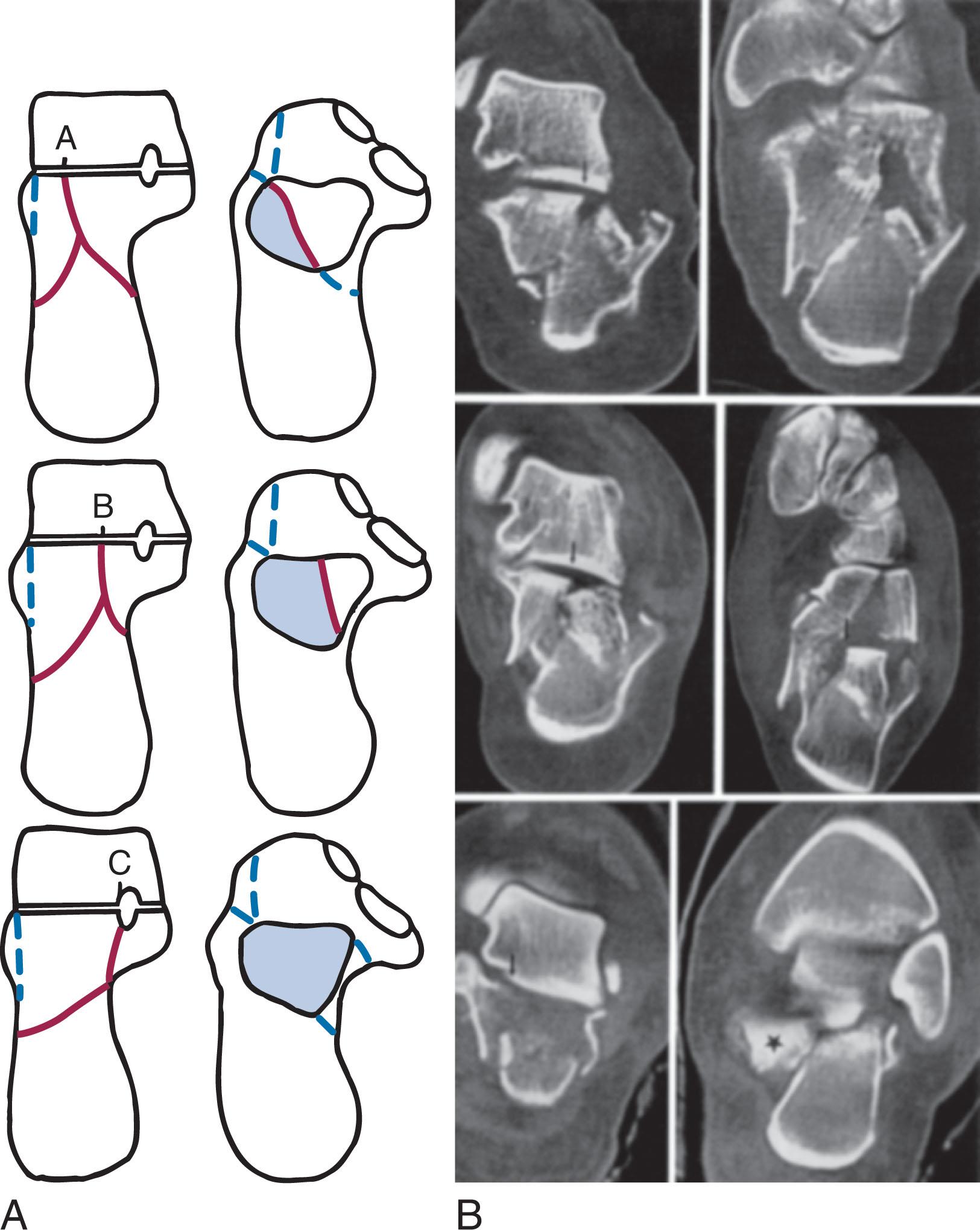
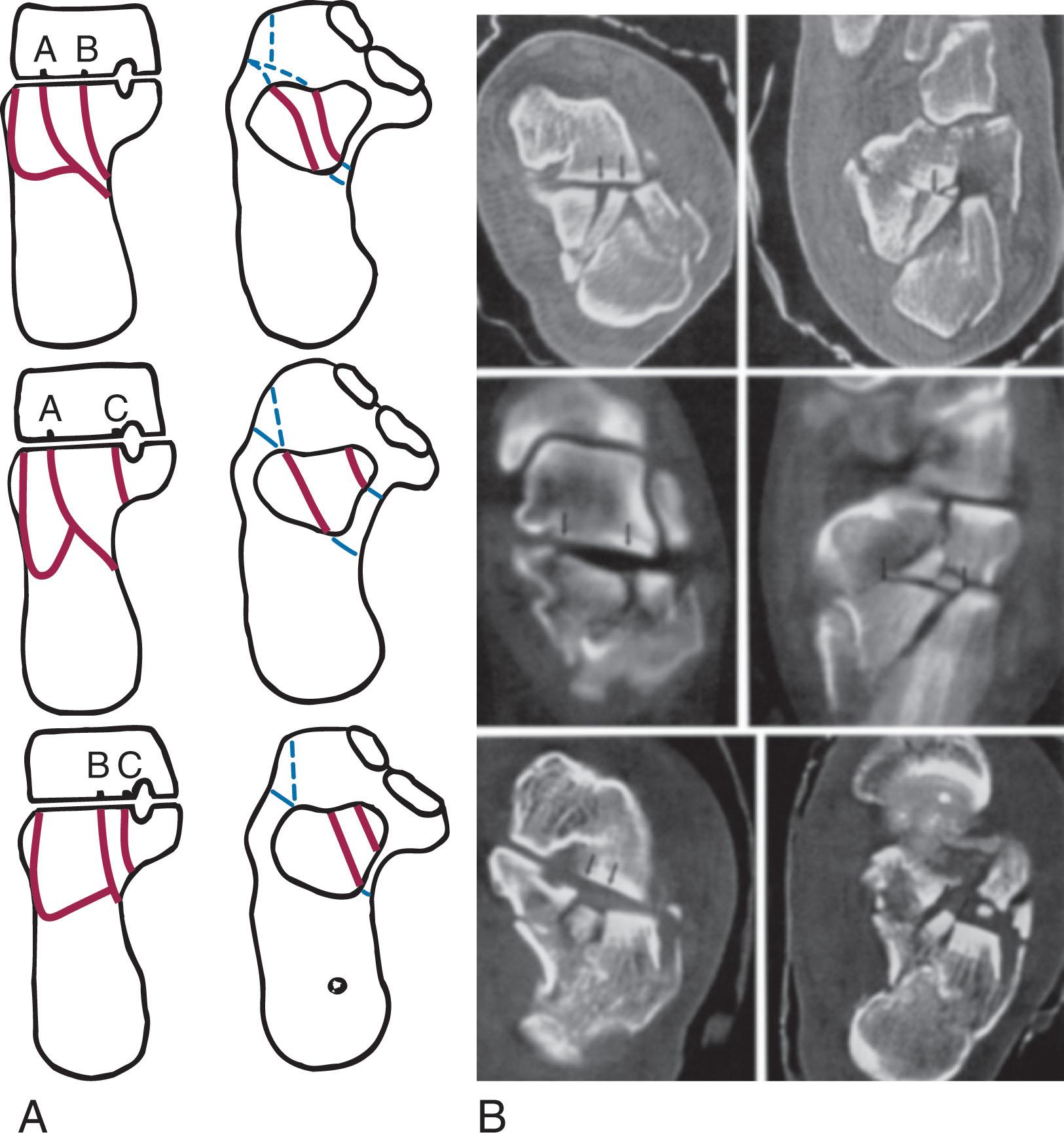
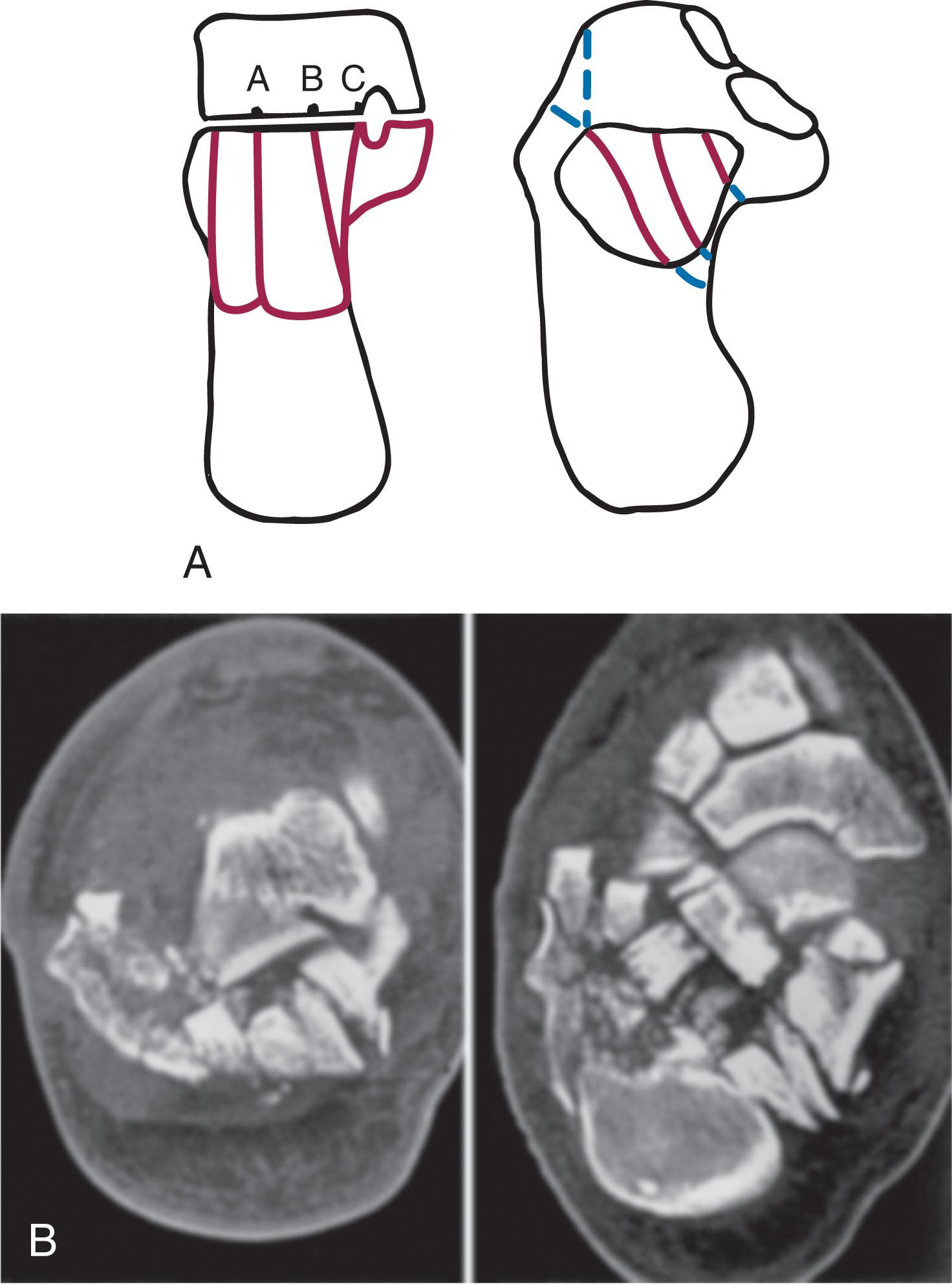
Although the Sanders classification was originally used for joint depression fractures, tongue-type fractures can also be classified. The classic extraarticular tongue-type fracture is typically a type IIC fracture, whereby the entire posterior facet is displaced but remains intact. If the tongue-type fracture includes intraarticular extension, it is usually a type IIB fracture. Other tongue-type fractures with joint-depression components (mixed-fracture variants) can also be classified according to the system of Sanders, as shown by Tornetta.
Fracture patterns of the anterior process of the calcaneus were described by Miric and Paterson. These fracture patterns are best visualized on the transverse CT images, and they typically mirror the same fracture lines traversing the posterior facet articular surface.
As early as 1908, Cotton proposed that an open reduction of a calcaneal fracture was contraindicated, preferring closed manipulation using a medially placed sandbag and a hammer laterally to reduce the lateral wall and “reimpact” the fracture. By the 1920s, however, he had abandoned treatment of acute fractures altogether, focusing instead on the treatment of healed malunion.
The first case reports on ORIF appear in the French literature in the 1910s, and Leriche published the first series of calcaneal fractures managed with internal fixation in 1922. Lenormant and colleagues proposed grafting of the subthalamic impaction zone after lifting the depressed joint fragment. Böhler later advocated open reduction of calcaneal fractures in 1931. Closed reduction and casting using tongs, hammers, and traction, however, remained the predominant treatment method at that time, largely because of technical problems with surgery. In 1935, Conn proposed that these fractures were best managed with a delayed triple arthrodesis; Gallie, however, concluded in 1943 that the transverse tarsal joints should be preserved and instead preferred a delayed subtalar arthrodesis. This technique soon became the standard of care and was later applied to acute calcaneal fractures as a primary subtalar arthrodesis, which remained the most commonly used technique well into the 1950s.
Fixation of tongue-type fractures was proposed first by Westhues in 1934, using a percutaneous “nail,” and later by Gissane, which led to the development of the Gissane spike specifically for the procedure. Essex-Lopresti then described his reduction technique in detail in 1952, specifically for tongue-type fractures. The technique was later attempted by others for all types of calcaneal fractures, causing it to fall into disfavor.
In 1948, Palmer published his results of open reduction of displaced intraarticular calcaneal fractures, using a lateral Kocher approach and stabilizing the lateral articular fragment with bone graft. Essex-Lopresti reported similar good results and believed that joint depression fractures required formal ORIF.
Operative treatment once again fell into disfavor in the late 1950s, largely as a result of a long-term follow-up study by Lindsay and Dewar of patients managed acutely by primary subtalar arthrodesis, the results of which suggested that a primary subtalar arthrodesis was unnecessary and that nonoperative treatment yielded the best results. Thus nonoperative management remained the preferred method of treatment throughout the 1960s and 1970s.
Significant advances in anesthesia, prophylactic antibiotics, internal fixation techniques, CT, and fluoroscopy since the 1970s have led to improved overall outcomes with surgical management of fractures. Several subsequent studies have applied these same principles to calcaneal fractures, and operative treatment of displaced intraarticular calcaneal fractures has become the standard of care for most fracture surgeons today. Although functional outcomes have improved with surgery, operative treatment remains challenging and can still be a source of considerable difficulty for surgeon and patient alike.
Nonsurgical management was the predominant historical treatment for all calcaneal fractures. It remains a common treatment and is indicated for nondisplaced or minimally displaced fractures (Sanders type I). This typically involves immobilization and limited weight bearing until fracture healing. An initial period of splint immobilization allows dissipation of the acute fracture hematoma. This is followed by conversion to an elastic compression stocking to lessen dependent edema and a prefabricated fracture boot locked in neutral flexion to prevent an equinus contracture. Early range-of-motion exercises are initiated when swelling allows. However, weight bearing is not allowed until radiographic union is confirmed, typically 6 to 12 weeks depending on the type of fracture. In recent years, we have seen a trend toward earlier mobilization, range-of-motion exercises, and partial weight bearing.
Patients with displaced fractures who are considered higher risk for surgical treatment can also be treated nonsurgically. Relative contraindications to surgery include smoking, poorly controlled diabetes, peripheral neuropathy, peripheral vascular disease, and serious medical conditions. Recent studies have suggested that chronological age should not be considered a contraindication to surgical treatment. One study demonstrated improved outcomes with surgical treatment compared to nonsurgical treatment in patients over 60 years of age. A retrospective study found equivalent outcomes with surgery comparing patients who were older or younger than 50 years of age.
Kitaoka et al reviewed their small series of patients treated with closed casting without manipulation, using gait analysis to assess outcome. Most patients demonstrated an altered gait pattern, particularly with uneven ground, thereby confirming that nonoperative management of displaced calcaneal fracture results in at least some permanent functional impairment.
The optimal treatment for patient with displaced intraarticular calcaneal fractures remains controversial. Until recent decades, nonsurgical treatment was preferred for all calcaneal fractures. The risk of complications with surgery was considered too high and the benefit of surgical treatment was not clearly established. Now, however, surgical treatment is common for displaced fractures. We have seen improved approaches for management of the associated soft-tissue injury and decrease rate of complications. In addition, new implants and advanced imaging have helped our ability to obtain and maintain anatomic reduction with surgical treatment.
Many studies have compared outcomes of surgical versus nonsurgical treatment. Several have been limited by small patient populations, inconsistent fracture classification, and variations in surgical technique. The first prospective randomized trial included 30 patients with displaced fractures (Sanders type II or III). These were randomized to operative versus nonoperative treatment. Operative treatment consisted of open reduction internal fixation with an extensile lateral approach. Results were promising for surgical treatment as the surgery group had a statistically significant improvement in functional outcome at 17 months follow-up.
There have since been three large randomized controlled trials comparing surgical versus nonsurgical treatment for displaced fractures. All of these utilized the extensile lateral approach for surgical intervention, and all showed increased complication rates in the surgically treated group. None of these studies showed clear superiority of surgical treatment over nonsurgical treatment.
The largest multicenter randomized study included 424 patients with displaced intraarticular calcaneal fractures, classified by Sanders classification with CT imaging. Validated outcomes measures showed no difference between the two groups at 2 to 8 year follow-up (average 3 year). Subgroup analysis did indicate improvement with surgical treatment in women, younger patients, patients with severely displaced fractures, and those without a workers’ compensation claim. In addition, patients undergoing surgical treatment were much less likely to require subsequent subtalar joint arthrodesis for posttraumatic arthritis. Despite being a well-designed study with a large number of patients, this study did not clearly demonstrate the optimal treatment for displaced fractures.
A second randomized controlled trial compared 82 patients with 8- to 12-year follow-up. At 1 year postinjury there was no difference in pain and functional outcome between those treated with surgery versus nonsurgical treatment. At final follow-up there was a trend toward improved function in the surgically treated group, but this was not statistically significant. The surgically treated group had a higher complication rate and showed a lower incidence of posttraumatic subtalar arthritis.
The most recent randomized study included 151 patients and 22 centers comparing surgical versus nonsurgical treatment. The Kerr-Atkins scale was used to assess pain and function. Two year follow-up data were obtained for 95% of patients and showed no difference between the treatment groups. The surgically treated group did have a higher complication rate (23% vs. 4%). The authors recommended nonoperative treatment for displaced calcaneal fractures based on these results.
Most experts, however, caution against such a definitive conclusion. This is a complex issue to study and all relevant studies have limitations. The best treatment for displaced calcaneal fractures remains controversial. Many surgeons now utilize less invasive surgical techniques for surgical treatment that have lower rates of wound complications. So far, no randomized studies have compared outcomes of less invasive surgical treatment to nonsurgical treatment.
In addition, several meta-analyses have been performed to address this question of operative versus nonoperative treatment. Results of these studies are also inconclusive. Limitations include relatively small numbers and some heterogeneity in treatment protocols. None of these studies found surgical treatment to be clearly superior to nonoperative treatment. The surgical treatment groups demonstrated decreased rate of subtalar joint arthrosis, increased rate of return to work, improved anatomic recovery radiographically, and increased complication rates.
In completing preparations for surgery, the surgeon should thoroughly review the plain radiographs and CT scans to gain a preliminary understanding of the personality of the fracture. In addition to following the primary fracture line on the coronal CT images as it traverses the posterior facet, the axial CT images are observed for fracture lines in the anterior process, which typically mirror those dividing the posterior facet articular surface. In addition, the axial cuts can also reveal a medial-to-lateral extraarticular fracture at the anterior margin of the posterior facet, as originally identified by Carr. This particular fracture line is important to identify because its presence indicates that the medial portion of the posterior facet may be rotated plantarward, in which case it would need to be elevated out from beneath the anterior process to obtain an anatomic reduction.
We have found difficulty in determining whether a given sagittal plane fragment is additionally fractured in the coronal plane. Such information can be difficult to ascertain preoperatively because neither reformatted images nor three-dimensional CT scans can identify this particular fracture line. Thus, this fracture line can go unnoticed until the time of surgery, and on occasion, it might not be recognized until the fragment displaces during attempted repositioning intraoperatively.
The extensile lateral approach has been the gold standard for operative treatment of displaced intraarticular fractures. The primary goal of surgery is anatomic restoration of alignment and joint congruity and return of function without pain. The extensile lateral approach allows reduction of the calcaneal body and restoration of calcaneal height, length, and width, regardless of the extent of comminution, as well as reduction of the intraarticular surface where possible.
The work of Sanders et al demonstrates several critical factors in the management of these injuries. They reported on 120 displaced, intraarticular calcaneal fractures (Sanders types II–IV), using an extensile lateral approach, lag screw fixation of the articular surface, and neutralization plate fixation of the calcaneal body. Postoperative CT evaluation revealed full restoration of calcaneal height, length, and width in all fracture types; restoration of the Böhler and Gissane angles to within 5 degrees of normal in all but three patients; and an anatomic articular reduction in 86% of Sanders type II and 60% of Sanders type III fractures, but in none of the Sanders type IV fractures. Their results confirmed that full restoration of calcaneal anatomy was attainable through an extensile lateral approach. They noted a temporal learning curve requiring up to 50 cases or 2 years’ experience before consistent, predictable results could be expected for type II and III fractures. Similar results were obtained from a recent meta-analysis. Fourteen of their 17 type II and III fractures requiring subtalar arthrodesis had an anatomic articular reduction at the time of arthrodesis, indicating that articular damage at the time of the original injury can lead to posttraumatic arthritis despite an anatomic reduction. They also concluded that the articular surface in type IV fractures was not salvageable and that primary arthrodesis after restoration of calcaneal morphology was indicated.
Timing of surgery with the extensile lateral approach is critical. Surgery should be performed within the first 3 weeks of injury before early consolidation of the fracture. Once fracture consolidation ensues, the fragments become increasingly difficult to separate to obtain an adequate reduction, and the articular cartilage can delaminate from the underlying subchondral bone. Increased rates of wound complications have been observed when surgery was delayed more than 2 weeks because soft tissue retraction and beginning fibrous union make anatomic reduction increasingly difficult to obtain, leading to more strain on the soft tissues.
Surgery should not be attempted, however, until the associated soft tissue swelling has adequately dissipated, typically 7 to 14 days after injury, as demonstrated by a positive wrinkle test . The test is performed by visual assessment and direct palpation of the lateral calcaneal skin, with the involved foot in dorsiflexion and eversion. The test is positive if skin wrinkling is seen and no pitting edema remains, thereby indicating that surgical intervention may be safely undertaken ( Fig. 45-20 ). So the optimal window for surgical treatment with the extensile lateral approach is between 7 and 21 days after injury, once swelling has resolved but before fracture consolidation has begun. Less invasive approaches can be safely performed earlier and should be considered in cases with more severe swelling where the extensile lateral approach would be significantly delayed.
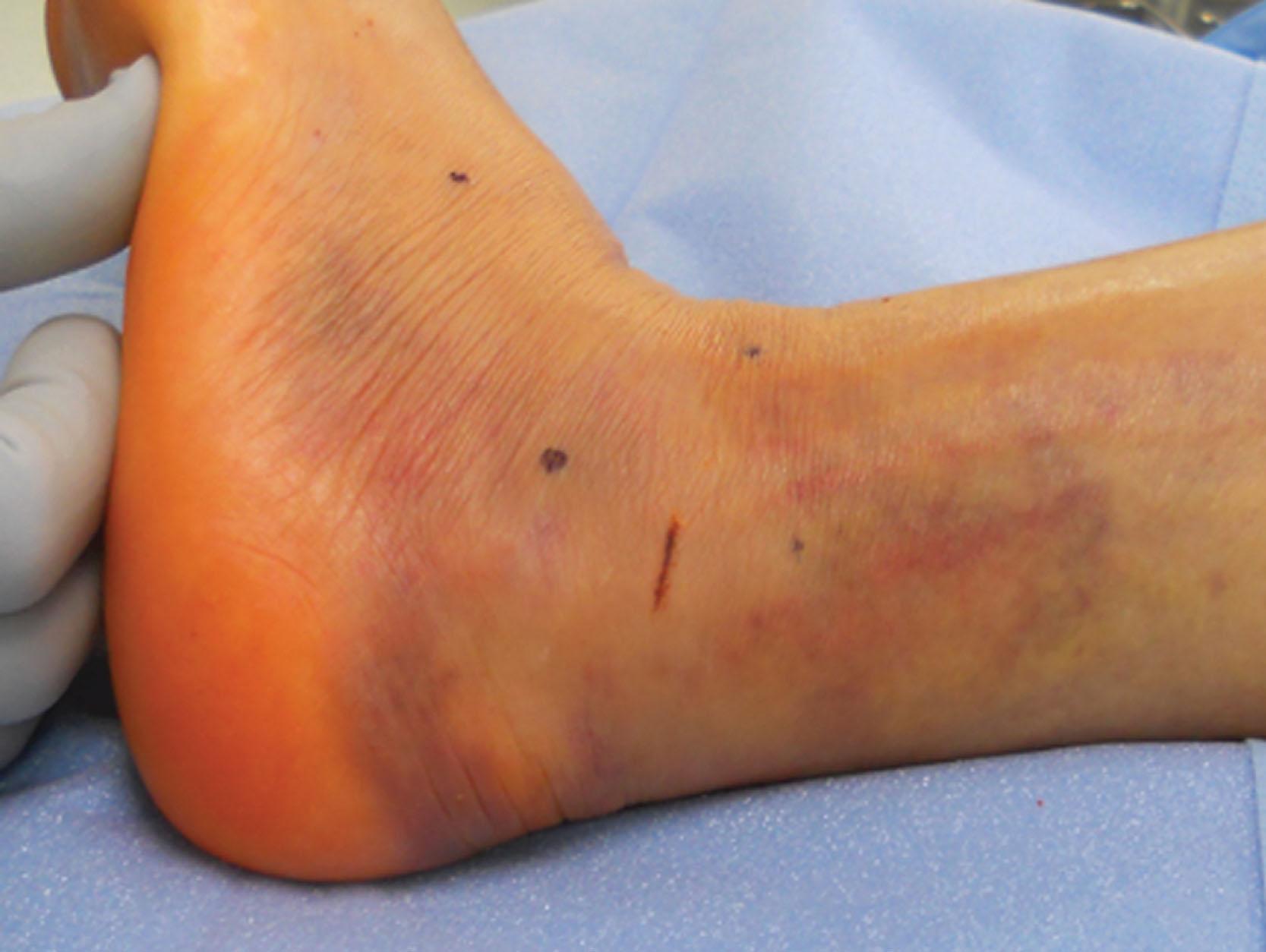
A variety of methods may be used to reduce swelling in the affected extremity. If the patient is seen in the emergency department, immediate elevation in combination with a Jones dressing and supportive splint may be used. Good results have been reported with use of a foot pump with calcaneal fractures, which can accelerate edema resolution so that the involved limb may be suitable for surgery within 3 to 5 days. The authors’ experience with the foot pump has been less favorable because the device is exceedingly painful for the patient to use, and it can lead to rebound edema within the soft tissues, which then increases the risk of wound dehiscence and delayed wound healing. A Cryo Cuff (DJO Global, Guildford, Surrey, United Kingdom) is tolerated much better by the patient and similarly effective in reducing the swelling.
Because of the concern for wound complications with the extensile lateral approach, alternative less invasive approaches for surgical repair have been developed. The range of less invasive approaches include indirect and percutaneous reduction techniques, percutaneous internal fixation, sinus tarsi and posterior approaches for ORIF, and external fixation. These approaches have been shown to have lower rates of wound complications. In recent years, we have seen increased adoption of these techniques and expanding evidence on the safety and outcomes. In addition to decreased wound complications, some studies suggest that these techniques may result in decreased subtalar joint stiffness as compared to the extensile lateral approach. With less extensive periosteal stripping, postoperative scarring and stiffness may be decreased.
The management of soft tissues and timing of surgery is also different with minimally invasive techniques. Aggressive soft tissue management protocols have been described and can include inpatient admission, elevation, splinting, and sequential compression devices. With smaller incisions and less risk of wound complications, it is not necessary to postpone surgery until swelling is completely resolved. In fact, indirect reduction techniques are easier and more successful before early fracture consolidation occurs. It is safe to proceed with surgery within days of the injury in most cases. Protocols vary, but most surgeons recommend proceeding within 5 days of the injury. One study demonstrated an increase in wound complications with delay in surgery in patients undergoing surgery with a less invasive approach.
Another difference and potential advantage of less invasive approaches is the ability to consider surgical treatment in higher risk patients. With the extensile lateral approach, risk factors for wound complications are considered a relative contraindication to surgical treatment. Patients with poorly controlled diabetes, peripheral vascular disease, or who smoke cigarettes are considered high risk for surgery with the extensile lateral approach. Until recent years, nonsurgical treatment was frequently recommended for these patients. Less invasive approaches, however, can be considered and performed safely even in higher risk patients. Patients who otherwise would have been treated nonoperatively may have the option to benefit from surgical treatment with minimally invasive approaches.
Many studies have described treatment of displaced fractures with percutaneous techniques. Percutaneous and indirect reduction techniques are utilized, and fixation is achieved with percutaneously placed screws. Alternatively, use of small plates, K-wires, and external fixation have also been described.
Fifty-four patients undergoing percutaneous reduction and external fixation of displaced calcaneal fractures were followed prospectively for mean 4.1 years. Forty-nine of 54 patients had good to excellent clinical and radiographic result. Complications were minimal with no deep infections and three superficial pin site infections. Percutaneous transarticular fixation with K-wires was reported in 64 Sanders type II and III fractures. Six patients (9.4%) had superficial pin site infections, but no patients had deep infection. According to the Maryland Foot Score, 81% of patients had a good-to-excellent result. This technique may be a preferred option in settings with limited implant availability.
Another study reported on 37 patients treated with closed reduction and percutaneous screw fixation. This technique involved temporary spanning external fixation from the distal tibia to the calcaneal tuberosity. Percutaneous reduction was performed and internal fixation achieved with multiple cannulated screws. At 66-month follow-up, 2 patients required reoperation with subtalar fusion, but 17 patients (46%) were reoperated for hardware removal. Overall, five wound infections occurred. Patient satisfaction was 7.9 out of 10 and American Orthopaedic Foot and Ankle Society score was 84 out of 100. Despite concern regarding the high rate of reoperation for hardware removal, these results suggest that the percutaneous approach is a safe alternative to the extensile lateral approach. The largest case series with the percutaneous approach presented results on 152 consecutive patients with 182 fractures. These patients underwent percutaneous reduction and screw fixation. At 1-year follow-up, they reported 9.3% screw irritation, 5.5% reoperation for subtalar fusion, and 0.9% deep infection. Bohler’s angle, calcaneal height, and width were all improved.
Percutaneous reduction and plate fixation has also been described. One randomized controlled trial has compared minimally invasive percutaneous plating technique to conventional treatment with an extensile lateral approach. The operative time was less in the minimally invasive group (52.5 vs. 82.8). Wound-healing problems were significantly less in the minimally invasive group (6.7 vs. 37.1%), and there were no deep infections in the minimally invasive group. Patient-reported outcome scores and radiographic data were not different between the groups. Based on multiple studies, percutaneous reduction and fixation has been shown to be a safe alternative to the extensile lateral approach, with lower rates of wound complications and similar clinical and radiographic outcomes. Similar results are found in retrospective studies. One reported on 21 patients treated with minimally invasive approach with percutaneous reduction and plate fixation utilizing a standard large lateral plate. They demonstrated improvements in Bohler’s angle, Gissane angle, and calcaneal width. Good-to-excellent results were obtained at 12 to 18 months in 85.7% of patients according to the Maryland foot scoring system. They reported 14.3% soft tissue complications but no deep infections.
A retrospective comparative study looked at results of percutaneous technique with screw fixation (79 patients) versus open reduction internal fixation via an extensile lateral approach (41 patients). Reduction based on Bohler’s angle and maintenance of reduction was not different between the groups. The percutaneous group demonstrated a lower rate of deep wound infections (0/83 compared to 6/42) and minor wound complications (5/83 compared to 9/42). Rates of reoperation for subtalar fusion and hardware removal were not different between the groups.
The most common less invasive approach for surgical treatment of calcaneal fractures is the sinus tarsi approach. This approach is familiar to foot and ankle surgeons because it is routinely used for elective procedures such as subtalar arthrodesis. This approach allows visualization and access to the posterior facet for open reduction internal fixation through a relatively small incision. This approach is generally combined with percutaneous reduction and screw fixation of the calcaneal tuberosity.
There are a small number of high level-of-evidence studies that support the use of a limited incision approach to the posterior facet for calcaneal fracture ORIF. One randomized controlled trial compared the sinus tarsi approach to the extensile lateral approach in 64 patients. Four patients (12.5%) in the extensile lateral approach group and no patients in the sinus tarsi group had wound complications, although this was not statistically significant. Clinical outcomes (VAS and AOFAS) were better in the sinus tarsi group at 6 months, but at 12 months there was no difference between the groups. Radiographic outcomes showed no difference in Bohler’s angle and posterior facet reduction between the groups. There was improved restoration of calcaneal width in the extensile lateral approach group. Operative time was less in the sinus tarsi group and notably subtalar motion was also better in the sinus tarsi group.
A recent meta-analysis also found no difference in radiographic outcomes (Bohler’s and Gissane’s angles) between the sinus tarsi approach and the extensile lateral approach. This corroborates early reports and case series with this approach that demonstrated that anatomic reduction was radiographically equivalent to that obtained with the extensile lateral approach, and that the less invasive approach resulted in decreased wound complications, superficial infection, sural nerve injury, operative time, and time to the operating room. One of the first studies compared outcomes of 33 fractures treated with the sinus tarsi approach and 79 treated with the extensile lateral approach. There was no difference between the groups in terms of patient satisfaction or patient-reported outcomes (Medical Outcomes Study Short Form-36, Foot Function Index, and visual analog pain scale). Wound complications, however, were much lower with the less invasive approach, 6% versus 29%. Three additional comparative studies have demonstrated no difference in radiographic outcomes with the limited open sinus tarsi approach compared to the extensile lateral approach. Clinical outcomes including patient-reported pain and function were also similar between the groups. The less invasive approach demonstrated decreased wound complications (0 vs. 11 major wound complications in one study), decreased operative time, and decreased wait time to surgery.
The limited open sinus tarsi approach has also been compared to alternative minimally invasive approaches, including two randomized trials. The first compared a limited posterior longitudinal approach to the sinus tarsi approach in 167 patients. There was no difference in outcomes for Sanders type II and III fractures. For type IV fractures, however, the sinus tarsi group had superior clinical outcomes. Another study compared percutaneous fixation with calcium sulfate cement to the sinus tarsi approach in 80 patients. For Sanders type II fractures, there was no difference in clinical outcomes; in type III fractures, however, the sinus tarsi group was superior in terms of clinical outcomes. Of note, the percutaneous screw fixation group had lower complication rates and operative time. These studies suggest that for more complex intraarticular injuries, the sinus tarsi approach may be preferred. The visualization and access to the posterior facet articular fragments is better with the sinus tarsi approach and may explain the improved outcomes.
Even a few years ago, the extensile lateral approach was considered the gold standard against which other techniques were compared. In recent years, the adoption of the limited open sinus tarsi approach has been rapid; we have seen the continued trend from the extensile lateral approach to less invasive approaches. The data support this with multiple studies demonstrating equivalent radiographic and clinical outcomes and decreased wound complications. It appears that we are witnessing the transition; moving forward the limited open sinus tarsi approach will be the gold standard for surgical treatment of most intraarticular calcaneal fractures.
As less invasive approaches become more common, controversy has arisen as to when the extensile lateral approach is needed, and whether all trainees and surgeons need to first establish competence with the extensile lateral approach before beginning their learning curve with less invasive approaches. Across our subspecialties, we have seen this same trend from open extensive exposures to more limited and less invasive techniques. For example, this situation is analogous to rotator cuff repair, where we have seen the transition from traditional open surgery to less invasive techniques. Although fundamentals of surgical technique and knowledge of anatomy are essential for any surgical approach, it does not seem that trainees need repetitions with extensile open approaches in order to be safe and effective surgeons with less invasive techniques. We may not need to learn to “walk before we can run.”
An additional advantage of the sinus tarsi approach is that it can be utilized to deal with unusual or combined fracture patterns (e.g, split tongue fractures, fracture-dislocations). The combination of limited open approach to the joint and percutaneous fixation can be applied to any fracture pattern. In addition, it is the preferred approach for primary arthrodesis in severe type IV fractures, so the final decision about osteosynthesis versus fusion can be made intraoperatively with direct inspection of the articular fragments.
Become a Clinical Tree membership for Full access and enjoy Unlimited articles
If you are a member. Log in here